Who were the 5 people killed on board the OceanGate Titanic submersible
They included OceanGate's CEO, a researcher, pilot and a businessman and son.
After days of desperate searches throughout the Atlantic Ocean, the U.S. Coast Guard announced Thursday that the five passengers aboard the missing submersible vessel were killed when vessel suffered a catastrophic implosion.
Stockton Rush, Shahzada Dawood, his son Suleman Dawood, Hamish Harding and Paul-Henri Nargeolet were inside the vessel that embarked on the deep-dive tour, according to OceanGate, the company that operated the submersible. Their families were notified after debris of the vessel was found on the ocean floor, according to the Coast Guard.
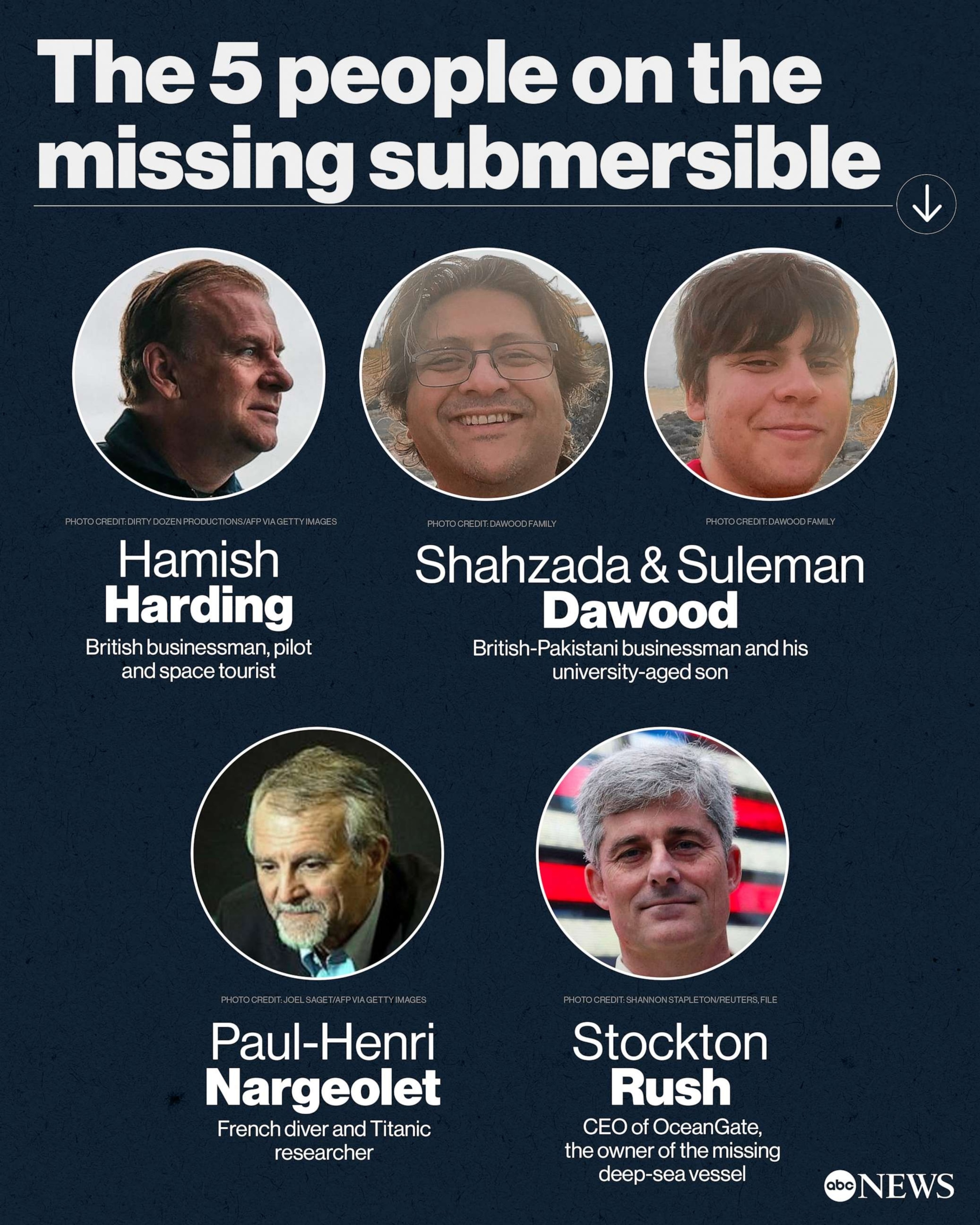
"Our hearts are with these five souls and every member of their families during this tragic time. We grieve the loss of life and joy they brought to everyone they knew," OceanGate said in a statement Thursday.
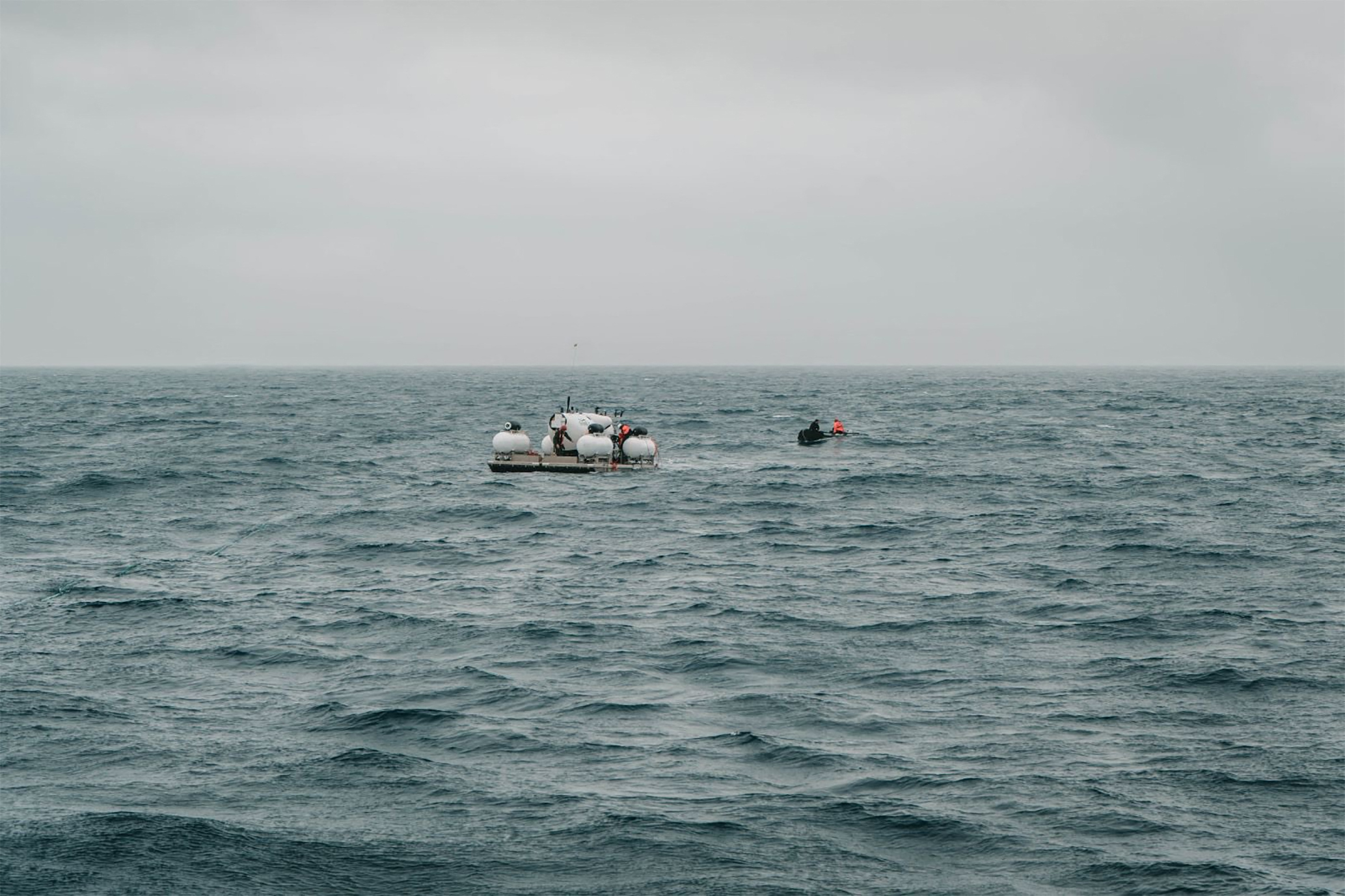
The submersible was designed with life support to sustain five crew members for 96 hours. On Thursday, the Coast Guard said it found debris on the ocean floor that was consistent with "catastrophic loss of the pressure chamber," roughly 1,600 feet from the Titanic wreckage.
The investigation into the incident is ongoing.
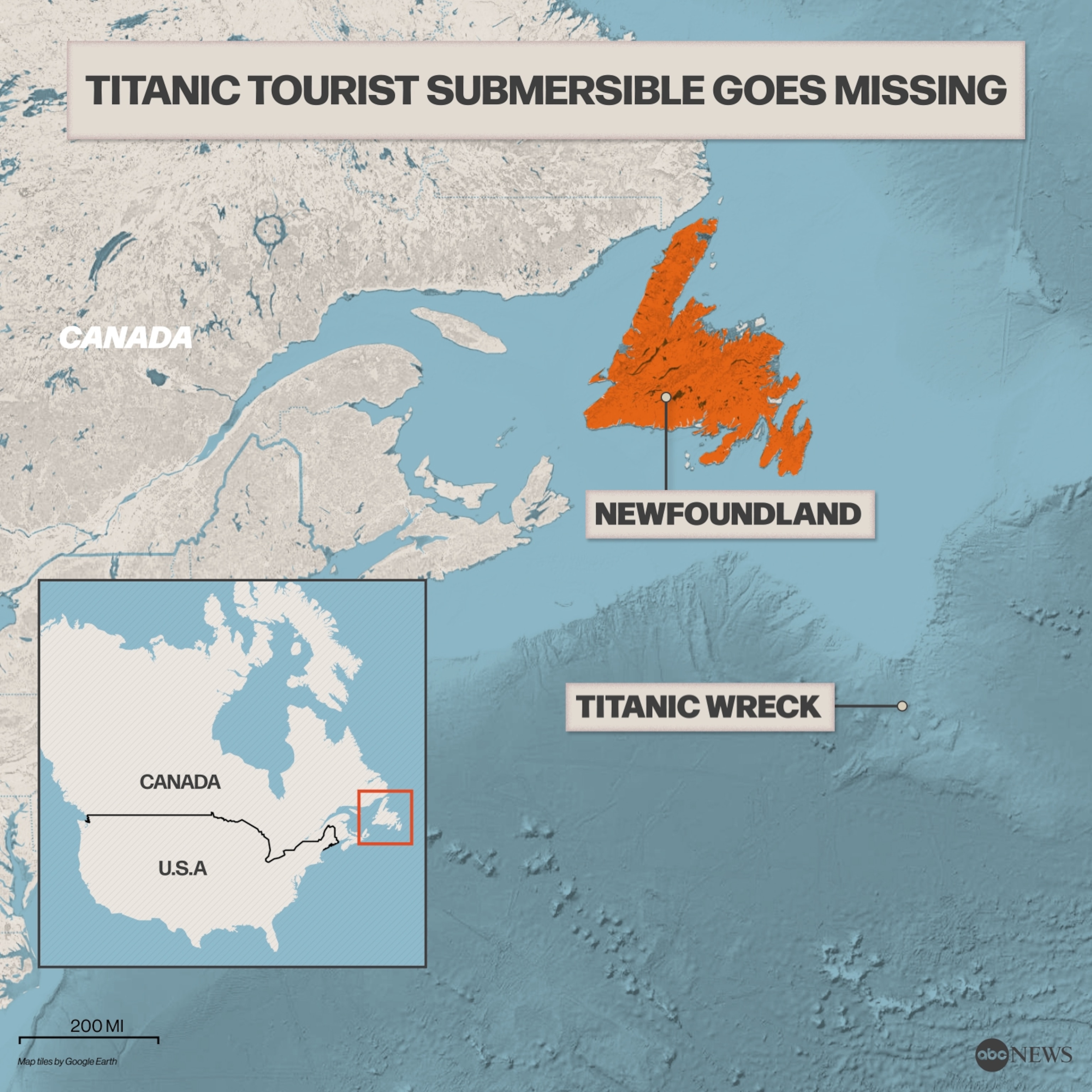
Here's what we know about the victims.

Hamish Harding
Hamish Harding was no stranger to exploration.
Harding circumnavigated the Earth in 2019. He made a dive in 2021 to the deepest point on earth, Challenger Deep, in the Mariana Trench. And he traveled into space last year aboard Blue Origin's New Shepard.
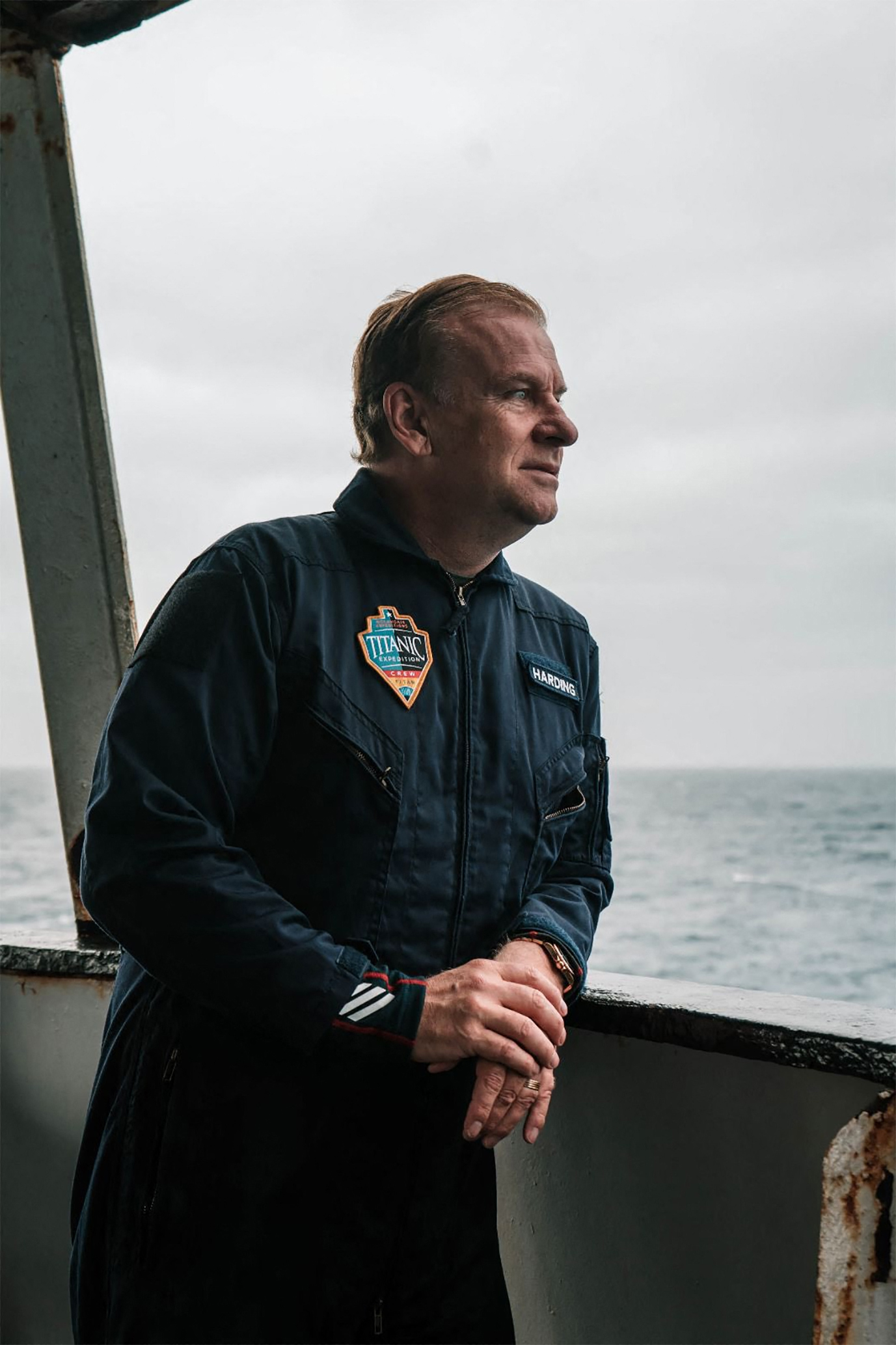
Harding, a British businessman and chairman of Action Aviation, previewed his dive to see the Titanic shipwreck in a Facebook post.
"Due to the worst winter in Newfoundland in 40 years, this mission is likely to be the first and only manned mission to the Titanic in 2023," he posted on Sunday. "A weather window has just opened up and we are going to attempt a dive tomorrow."

Harding, a licensed air transport pilot who holds three Guinness World Records, was "an extraordinarily accomplished individual who has successfully undertaken challenging expeditions," Action Aviation said in a statement.
Along with his ocean dives and blasting off to space, he helped with "the reintroduction of Cheetahs from Namibia to India" and "has been to the South Pole a number of times," the company said. Harding was inducted in 2022 as a Living Legend of Aviation.
On Thursday afternoon, Harding's family and Action Aviation released a statement saying they were "united in grief with the other families who have also lost their loved ones on the Titan submersible."
"Hamish Harding was a loving husband to his wife and a dedicated father to his two sons, whom he loved deeply," the statement read. "He was a passionate explorer – whatever the terrain – who lived his life for his family, his business and for the next adventure. What he achieved in his lifetime was truly remarkable and if we can take any small consolation from this tragedy, it’s that we lost him doing what he loved."
"We know that Hamish would have been immensely proud to see how nations, experts, industry colleagues and friends came together for the search and we extend our heartfelt thanks for all their efforts," the family and company added in their statement.
Shahzada and Suleman Dawood

Shahzada Dawood was vice chairman of Engro Corporation Limited, a sprawling business headquartered in Karachi, Pakistan. Suleman Dawood is his son, the family said in a statement.
The Dawoods were both British citizens, according to a colleague.
Shahzada Dawood, a husband and father of two, loved photography, gardening and exploring natural habitats, according to the family.

Suleman Dawood, a university student, was passionate about science fiction literature and learning new things.
Samad Dawood, Shahzada's brother, told ABC News he, his sister and his father all traveled to Newfoundland with hopes of better news.
MORE: Titanic submersible victims' family mourns: 'enormous tragedy and devastation'
Samad Dawood broke down in tears as he reflected on his nephew.
"He was so filled with humbleness and gratitude," he told ABC News. "I think it's sad but also amazing that... his death also brought the world together, and I thank him for it."

Samad Dawood said his brother "inspired in us audacity from a very young age."
"He was always the kind of person who had love for the world," Samad Dawood said. "He was a guy who just wanted to go out there, experience what the world had to offer, even though he himself pushed himself to do it."
The Dawood family released a statement Thursday expressing gratitude for everyone involved in the rescue operations.
"Their untiring efforts were a source of strength for us during this time," they said in the statement. "We are also indebted to our friends, family, colleagues and well-wishers from all over the world who have stood by us during our hour of need. The immense love and support we receive continue to help us endure this unimaginable loss."
"We extend our heartfelt condolences to the families of the other passengers on the Titan submersible," the family added. "At this time, we are unable to receive calls and request that support, condolences and prayers be messaged instead. Details of their final rites in this world will be announced soon."
In a statement Thursday night, Engro offered its condolences for both Shahzada and Suleman Dawood.
"With heavy hearts and great sadness, we grieve the loss of our Vice Chairman, Shahzada Dawood, and his beloved son, Suleman Dawood," the company said in the message. "Our thoughts and prayers are with the Dawood family at this tragic time."
"We extend our heartfelt condolences to the family, colleagues, friends and all those around the world who grieve this unthinkable loss," it added.
Paul-Henri Nargeolet
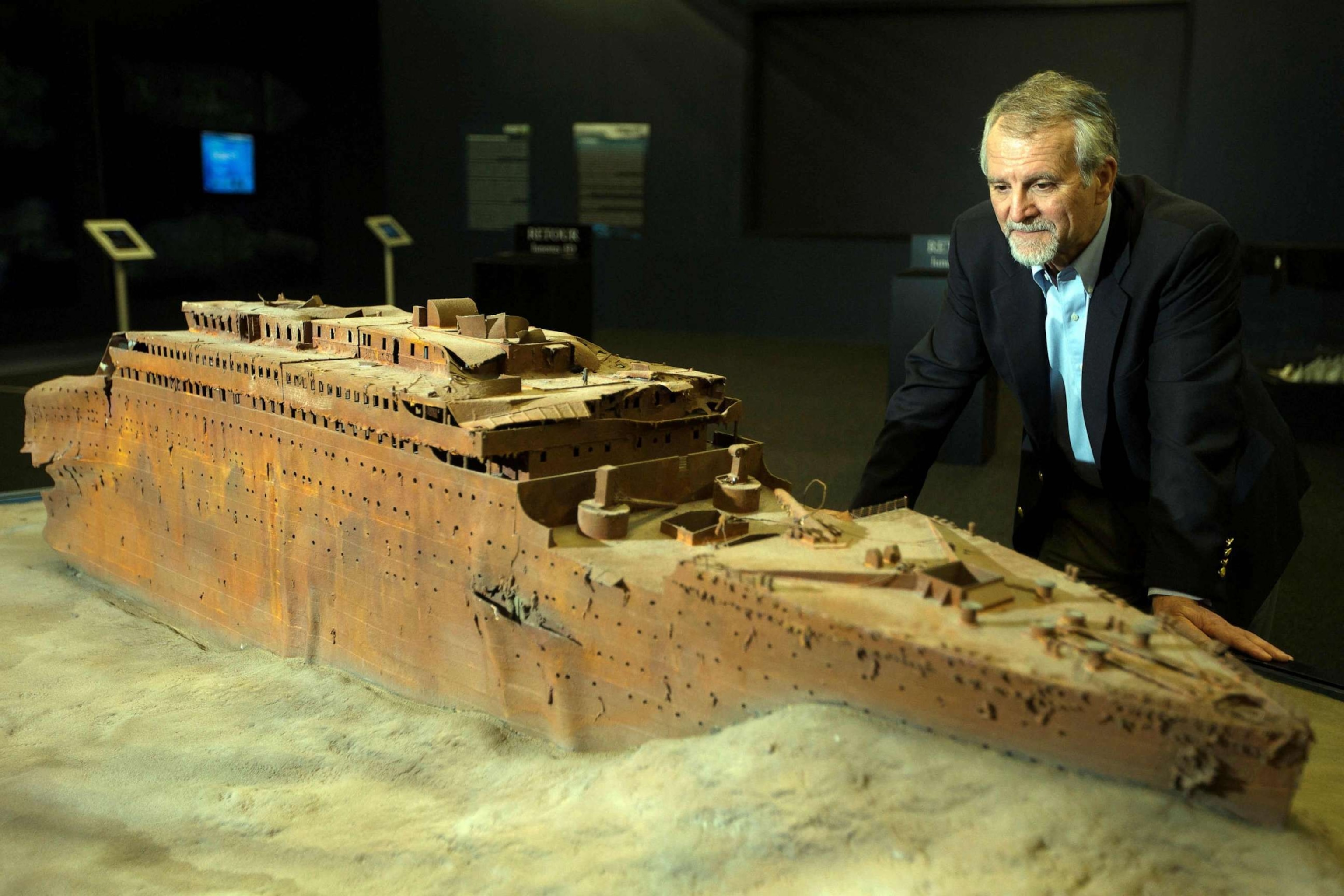
Paul-Henri Nargeolet, known as PH, a diver and Titanic researcher, was among the passengers. He was the director of Underwater Research at RMS Titanic Inc., according to the company .
Nargeolet led six expeditions to the Titanic site, most recently in 2010.
Stockton Rush

According to OceanGate's website, Stockton Rush "oversees OceanGate’s financial and engineering strategies and provides a clear vision for development of 4,000 meter (13,123 feet) and 6,000 meter (19,685 feet) capable crewed submersibles and their partner launch and recovery platforms."
Rush, who studied aerospace engineering at Princeton University and obtained an MBA from the University of California, Berkeley, "has written numerous engineering articles on crewed submersible vehicles in subsea operations," OceanGate's website said.
ABC News' Matt Foster, Miles Cohen, Mark Guarino, Emily Shapiro, Peter Charalambous, Sam Sweeney, Laryssa Demkiw, Gio Benitez and Victoria Beaule contributed to this report.
Related Topics
- Titanic submersible
Top Stories

'Surprising' and 'disturbing': Legal experts react to SCOTUS on Trump immunity case
- Apr 30, 6:52 AM

Trump trial: Trump hit with contempt, witnesses detail Stormy Daniels deal
- 2 hours ago

Explosion that killed 20 at army base was likely caused by mishandling of ammunition
- Apr 30, 5:47 AM

Trump says 'it depends' if there will be violence if he loses 2024 election to Biden
- Apr 30, 1:24 PM

4 big takeaways from Day 9 of Trump's hush money trial
Abc news live.
24/7 coverage of breaking news and live events
Who were the five passengers inside the missing Titan submersible?
The five people aboard a submersible that disappeared while on a quest to see the Titanic in the North Atlantic have died, a Coast Guard official said during a Thursday news conference.
Here’s what we know about the five men who set out on a costly expedition aboard the OceanGate vessel, named the Titan, and have died after a “catastrophic loss of the pressure chamber.”
Stockton Rush
Rush, the pilot of the submersible, was the founder and CEO of OceanGate, a private research and tourism company that has conducted more than a dozen underwater expeditions since 2010. The company was created in 2009 and had completed other dives to the Titanic wreck in the past two years.
Rush, 61, obtained his DC-8 Type/Captain’s rating at the United Airlines Jet Training Institute in 1981 at age 19, making him the youngest jet transport-rated pilot in the world, according to his biography on OceanGate’s website. His pilot license took him to Cairo; Damascus, Syria; Mumbai; London; Zurich; and Khartoum, Sudan.
He obtained a Bachelor of Science degree in aerospace engineering from Princeton University in 1984, and an MBA from the UC-Berkeley Haas School of Business in 1989. That year, Rush built a Glasair III experimental aircraft that he still flew in recent years, according to his company bio. He also finished a heavily modified Kittredge K-350 two-person submersible, in which he conducted more than 30 dives.
What to know about the missing submersible
In December, Rush told “ CBS Sunday Morning ” that he believed diving in his submersible was not particularly dangerous but that he worried about something happening that would keep him from returning to the surface.
“I mean, if you just want to be safe, don’t get out of bed,” he said. “Don’t get in your car. Don’t do anything. At some point, you’re going to take some risk, and it really is a risk-reward question.”
For Rush, ocean exploration was a calling. He told CBS that he dreamed of being an astronaut when he was a child but later realized he wanted to probe a different unknown.
“I wanted to be sort of the Captain Kirk,” he said . “I didn’t want to be the passenger in the back.”
Hamish Harding
Hamish Harding , 58, was a British aviation businessman and seasoned adventurer who set several world records for deep-sea travel and circumnavigating the Earth via airplane.
Harding, an aircraft pilot, posted on social media before the trip that he was set to travel to the Titanic wreckage on the Titan.
“This mission is likely to be the first and only manned mission to the Titanic in 2023,” he wrote on Instagram .
Harding was the founder and chairman of Action Aviation, a United Arab Emirates-based company that buys and sells aircraft. He was in his late 50s and served as a chair for the Middle East chapter of the Explorers Club, which describes itself as a “multidisciplinary, professional society dedicated to the advancement of field research, scientific exploration and resource conservation.”
Who is Hamish Harding, tycoon and adventurer on the missing Titanic sub?
Harding was a passenger last year on the fifth human spaceflight of Blue Origin, the private space company founded by Jeff Bezos, who is the honorary chair of the Explorers Club. (Bezos owns The Washington Post.)
Harding’s social media pages are filled with photos of planes, rockets, ships and shots of his adventures to destinations including the South Pole and the Mariana Trench.
Paul-Henri Nargeolet
Nargeolet, a 77-year-old retired French navy commander, was the director of underwater research for a media and exhibition company whose affiliate, RMS Titanic , is the exclusive steward of the wreck.
Nargeolet, nicknamed P.H., had “an unparalleled knowledge” of the wreckage, said Brandon Whited, trustee of the Titanic International Society, which traveled to the site with Nargeolet in the 1990s. Nargeolet could identify pieces of the ship’s stern, which is in shambles on the ocean floor, “like no one else can,” Whited said.
“He truly knows the ship and has almost an unbelievable passion for it,” Whited said.
Deep water, high pressure: Why the Titanic sub search is so complex
Nargeolet was born in Chamonix, France, and also lived across Africa for 13 years with his family. He served as a submarine pilot, ship captain and deep diver during his two decades in the French navy, according to his LinkedIn profile.
While working at the French marine science research institute IFREMER, Nargeolet ventured down to the Titanic for the first time in 1987 — two years after the wreckage was found. He told HarperCollins last year that he had intended to go in 1986, but the plan didn’t pan out.
Nargeolet described descending in a small submarine and silence falling when the passengers arrived at the wreck to see shining bronze anchors and chains, buffed clean by the sea, the print on them saying they were made in Glasgow still clear.
“We were extremely happy, finally, to start to dive to the Titanic,” he told HarperCollins in French. “And we absolutely didn’t know at the time that I would return as often as I have been able to do.”
Since then, Nargeolet led “several expeditions” to the site, completed 37 submersible dives — including with OceanGate — and oversaw the recovery of 5,000 artifacts, according to a biography on his company’s website.
Last year, Nargeolet published a book on the ship in French: “Dans les profondeurs du Titanic,” or “In the Depths of the Titanic.”
“He knew that area so well. That’s what’s so tragic,” said Michael Findlay, former president of the Titanic International Society and a friend of Nargeolet. “He’s made more dives to that location than anyone. And the fact that he’s among those that are missing, it’s almost too impossible to comprehend.”
Shahzada Dawood
British Pakistani businessman Shahzada Dawood, 48, and his son, Suleman, 19, were also on the expedition, their family confirmed in a statement. They were part of one of Pakistan’s most prominent business families.
Shahzada Dawood was the vice chairman of the Pakistani conglomerate Engro Corp., which has a mix of industrial interests including fertilizers, textiles and food. It is a subsidiary of family-owned Dawood Hercules, fronted by his father, Hussain Dawood. He planned business ventures in renewable energy and technology, the company said in a statement, and hoped to “solve meaningful problems for Pakistan” through that work and through Engro.
Dawood also directed the family’s Dawood Foundation and was a trustee of the SETI Institute, a California-based research organization that searches for extraterrestrial life. The institute’s president, Bill Diamond, said Dawood was humble by nature and fascinated by the question of whether intelligent life exists elsewhere in the universe.
In missing submersible and migrant disaster, a tale of two Pakistans
When he told Diamond about the submersible trip in April, Dawood expressed excitement at what he saw as an extraordinary opportunity. He wasn’t usually a risk-taker, Diamond said, but he seemed intrigued by the opportunity to explore the ocean — still a relatively unknown frontier for humans.
“He said this was going to an extreme depth in a private craft, so I think he understood this was kind of at the edges of technological capabilities for us, but he didn’t seem to dwell on the risk,” Diamond said.
Dawood held dual British-Pakistani citizenship and sat on a number of charitable boards, including some linked to Britain’s King Charles III. He spoke at the United Nations and frequented the World Economic Forum in Davos, Switzerland, where he shared his vision for a “sustainable future” and championed clean energy and business models that help uplift “low-income communities.”
He was a fan of wildlife photography, gardening, his dog and cat and exploring various natural habitats, his family said in the statement. He and his son, Suleman, were close friends, and he loved to cook and have philosophical conversations with his daughter, Alina, the family said.
Suleman Dawood
Suleman Dawood was the youngest member of the Titanic expedition. He grew up outside London in the leafy village of Long Ditton, in Surrey, with his father, businessman Shahzada, and mother, Christine, a professional development and life coach who has run an organic agriculture business in Pakistan’s Punjab region and sits on the board of the Dawood Foundation.
Suleman was a fan of science fiction books, solving Rubik’s Cubes and playing volleyball, his family said in a statement. He recently graduated from ACS International School Cobham, whose head teacher, Barnaby Sandow, told The Post before the news of the passengers’ deaths that the school community was “deeply concerned by the news” that Suleman and his father were on board the missing submersible.
“Our thoughts are with the family, friends and loved ones, during this difficult time,” Sandow said in a statement.
Suleman and his father “were each other’s greatest supporters,” sharing a passion for adventure and learning, the family said. Suleman planned to join Ergo after graduating from college. He had made friends at college, and his sister and cousins looked up to him “for friendship, advice and laughter.”
The Dawoods’ neighbors told the Daily Mail: “You couldn’t wish for lovelier neighbors. … The children are so sweet and polite.”
Timothy Bella, Victoria Bisset, Alice Crites and Ishaan Tharoor contributed to this report.
Missing Titanic submersible
The latest: After an extensive search, the Coast Guard found debris fields that have been indentified as the Titan submersible. OceanGate, the tour company, has said all 5 passengers are believed dead.
The Titan: The voyage to see the Titanic wreckage is eight days long, costs $250,000 and is open to passengers age 17 and older. The Titan is 22 feet long, weighs 23,000 pounds and “has about as much room as a minivan,” according to CBS correspondent David Pogue. Here’s what we know about the missing submersible .
The search: The daunting mission covers the ocean’s surface and the vast depths beneath. The search poses unique challenges that are further complicated by the depths involved. This map shows the scale of the search near the Titanic wreckage .
The passengers: Hamish Harding , an aviation businessman, aircraft pilot and seasoned adventurer, posted on Instagram that he was joining the expedition and said retired French navy commander Paul-Henri Nargeolet was also onboard. British Pakistani businessman Shahzada Dawood, 48, and his son, Suleman, 19, were also on the expedition, their family confirmed. The CEO of OceanGate , the submersible expedition company, was also on the vessel. Here’s what we know about the five missing passengers.

5 aboard Titanic tourist sub are dead after ‘catastrophic implosion’
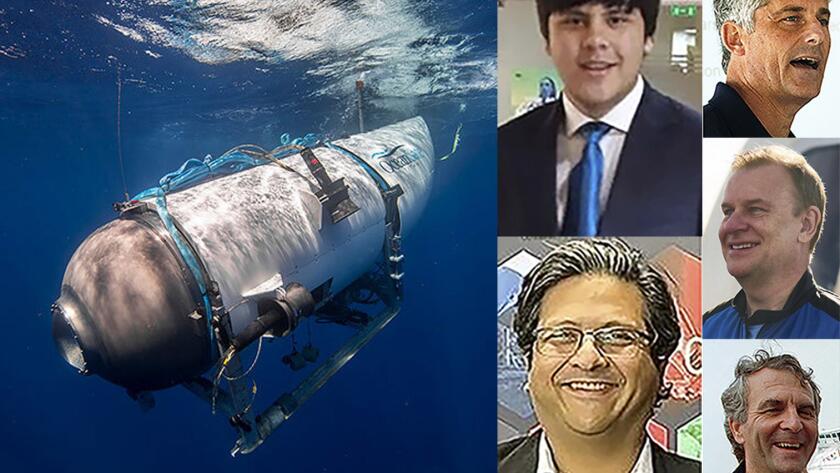
The five passengers on a sub that vanished on a trip to explore the Titanic wreckage have died after a catastrophic implosion, U.S. Coast Guard says.
- Show more sharing options
- Copy Link URL Copied!
All five passengers aboard a submersible that vanished while on a dive to explore the Titanic wreck site have died, officials said Thursday after underwater robots discovered seafloor debris from the sub that was “consistent with a catastrophic implosion.”
A robot from the Canadian vessel Horizon Arctic discovered several major pieces of the 21-foot sub, the Titan , in a debris field about 1,600 feet from the bow of the Titanic, U.S. Coast Guard Rear Adm. John W. Mauger said at a news conference.
“The debris is consistent with the catastrophic loss of the pressure chamber,” Mauger said.
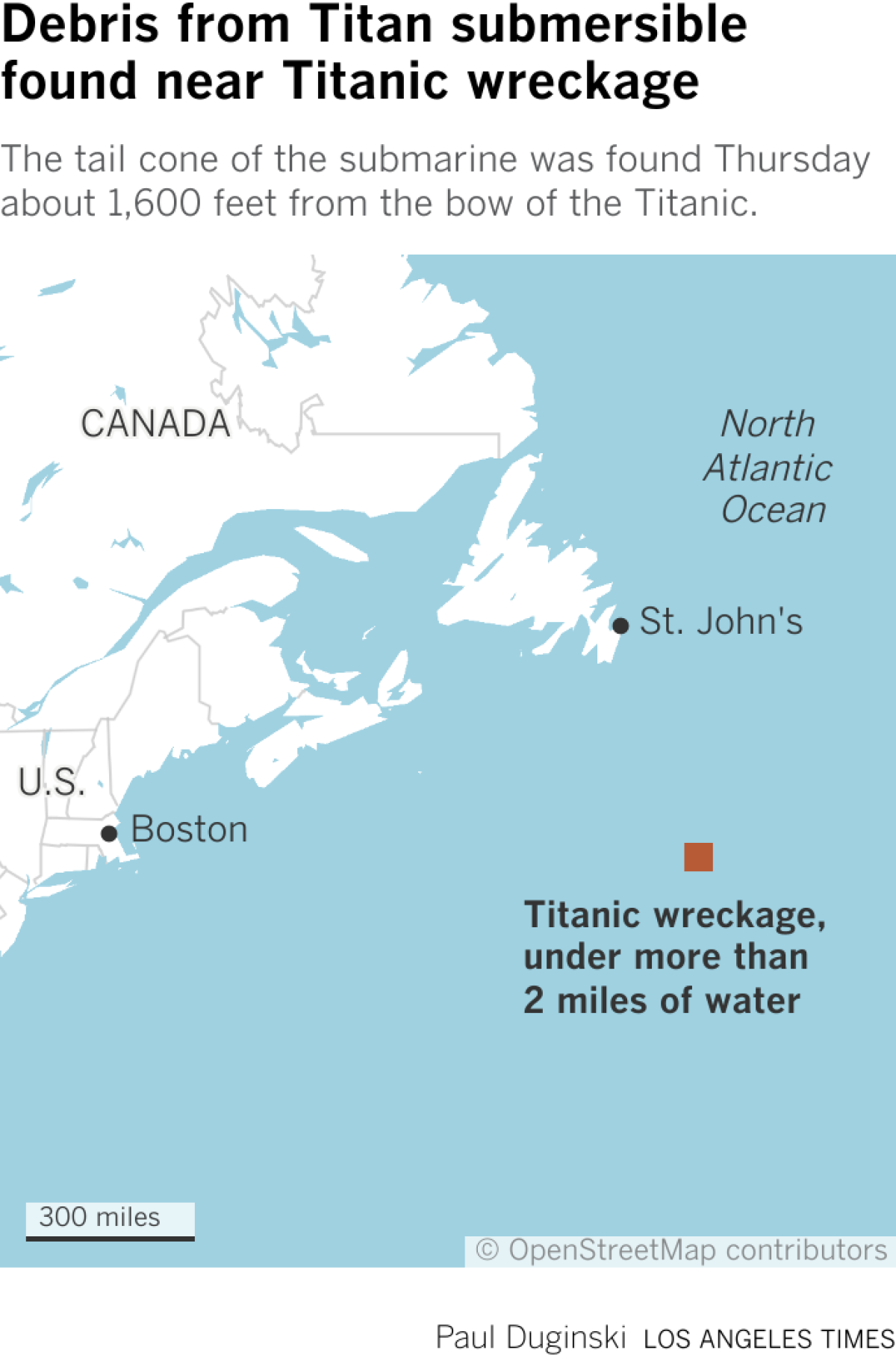
The families of the passengers have been notified, he said.
“On behalf of the U.S. Coast Guard and the entire unified command, I offer my deepest condolences to the families,” he said. “I can only imagine what this has been like for them. I hope that this discovery provides some solace during this difficult time.”
The five passengers were Stockton Rush, the pilot of the exploration and chief executive of OceanGate Expeditions, which owns and operates the sub; Hamish Harding , chairman of Action Aviation, a Dubai-based aircraft dealer; Paul-Henry Nargeolet, a veteran and accomplished diver with more than 30 trips to the wreck site; and Pakistani businessman Shahzada Dawood and son Suleman.

OceanGate said in a statement that its “hearts are with these five souls and every member of their families during this tragic time.”
“These men were true explorers who shared a distinct spirit of adventure and a deep passion for exploring and protecting the world’s ocean,” the company said. “We grieve the loss of life and joy they brought to everyone they knew.”

World & Nation
‘Catastrophic’ safety concerns raised about sub long before ill-fated Titanic voyage
Long before a submersible vanished on an expedition to explore the wreck of the Titanic, concerns were raised about the safety of the vessel.
June 21, 2023
The sub was reported missing after it lost contact with the Canadian research vessel Polar Prince about 1 hour and 45 minutes into its dive Sunday about 900 miles east of Cape Cod, Mass., the Coast Guard said.
Its disappearance set off an international search-and-rescue effort , as crews raced around the clock using specialized equipment to find the sub, which was designed to have an initial air supply of 96 hours. Officials also said it had only “limited rations” of food and water.
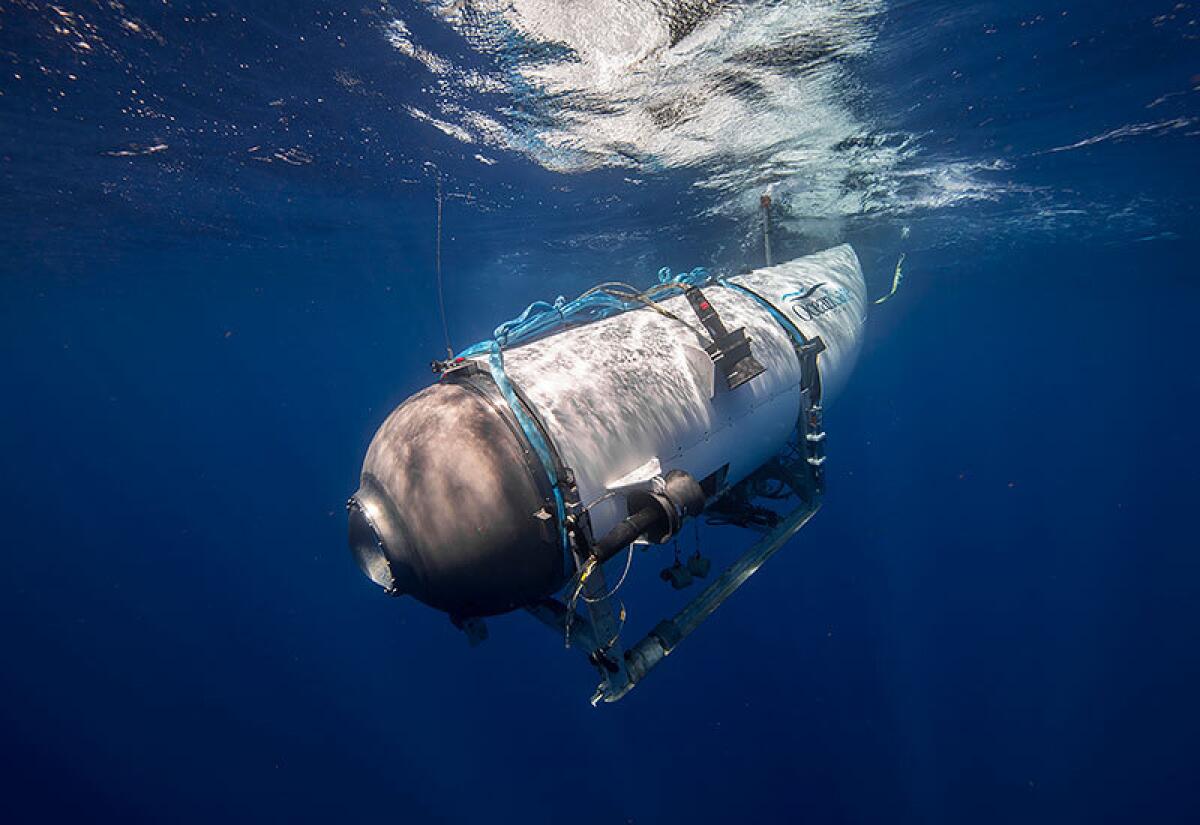
The search grew to 10,000 square miles, roughly the size of Massachusetts, and went 2½ miles deep. Through the days-long effort, officials maintained optimism that the operation would remain a search-and-rescue effort and not a recovery mission.
Assets launched in the search included American and Canadian aerial support vessels that scanned the ocean’s surface and subsurface using sonobuoys; U.S. Navy divers; coast guard and research vessels from Canada, France and Norway, some of which were equipped with highly specialized remote-operated vehicles that could work on the ocean’s floor; and assistance from commercial vessels.
A moment of promise came Tuesday when the Coast Guard confirmed reports that banging noises were detected on the seafloor by sonobuoys dropped from Canadian aircraft. Although officials said the origins of the sounds were unclear, they became the target of search efforts.
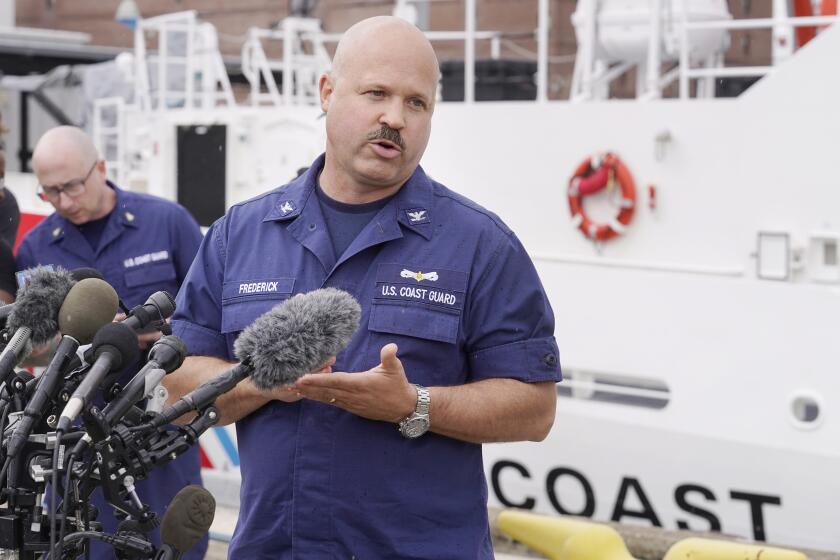
Sounds described as ‘rhythmic tapping’ on hull heard in search for Titanic tourist sub
The use of remotely operated vehicles in the search for the Titanic tourist submersible carrying five people has yielded no results, the U.S. Coast Guard said.
At the news conference Thursday, Mauger said the underwater noises , which were also observed Wednesday, did not appear to be connected to the sub’s location. The implosion would generate “significant broadband sound” that would have been picked up by the sonobuoys, he said.
Paul Hankins, a salvage expert for the U.S. Navy, said five major pieces of debris from the Titan were found, including the nose cone, which was outside of the pressure hull. Crews also found a large debris field that contained the front-end bell of the pressure hull.
“That was the first indication there was a catastrophic event,” he said. A second, smaller debris field contained the other end of the pressure hull and other wreckage that compromised the totality of the vessel.
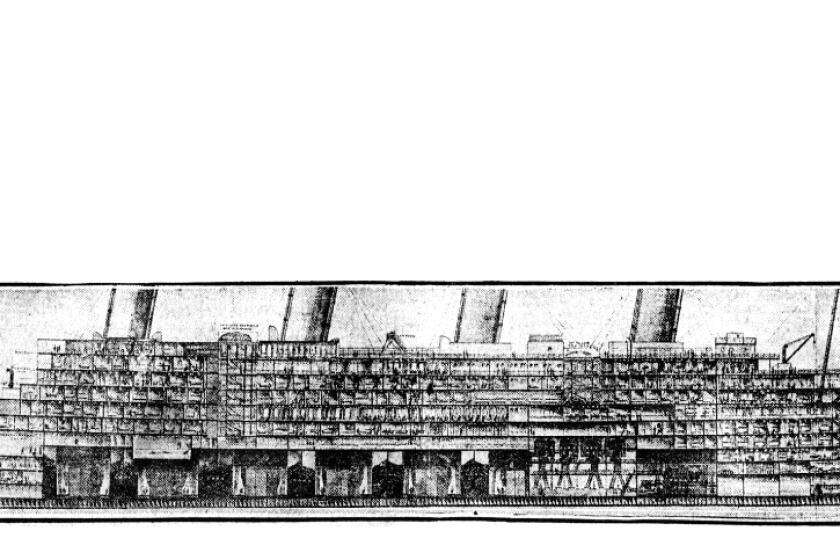
How The Times covered the sinking of the Titanic: ‘The annihilated Leviathan’
June 22, 2023
Officials said that the debris was in an area away from the Titanic wreckage in a patch of smooth ocean floor and that there were no signs the vessel collided with the historic ship. The size of the debris field and the vessel’s last-known location are consistent with an “implosion in the water column,” officials said.
Mauger said it is too early to tell when the vessel imploded, and added that listening equipment used throughout the search did not detect any type of catastrophic event.
However, a U.S. government official familiar with the incident but not authorized to speak to the media told The Times that technology designed to listen to the ocean for movement captured the sound of the submersible imploding around the time communications were lost. The news was first reported by the Wall Street Journal, which noted the sound “anomaly.”
When asked whether the victims’ remains might be recovered, Mauger said he did not have an answer, reiterating the implosion and underlining the ocean’s harsh conditions. “This is an incredibly unforgiving environment down there on the seafloor,” he said.
Like the search-and-rescue efforts, the investigation into what happened will be complex, Mauger said, because of the remote location where the event occurred and because it involves the government agencies of several countries whose citizens were aboard.
The composite material used to build the sub and a lack of safety systems will be the focus of a maritime inquiry, which most likely will involve Canadian and U.S. investigators, according to sources familiar with such operations.
Nine vessels were at the location Thursday, and demobilization efforts are expected to take place over the next 24 hours. But remote-operated vehicles will continue to map the ocean floor, Mauger said, and officials are working to develop a timeline of the implosion.
“I know that there’s also a lot of questions about how, why and when did this happen,” Mauger said. “Those are questions that we will collect as much information as we can on now.”
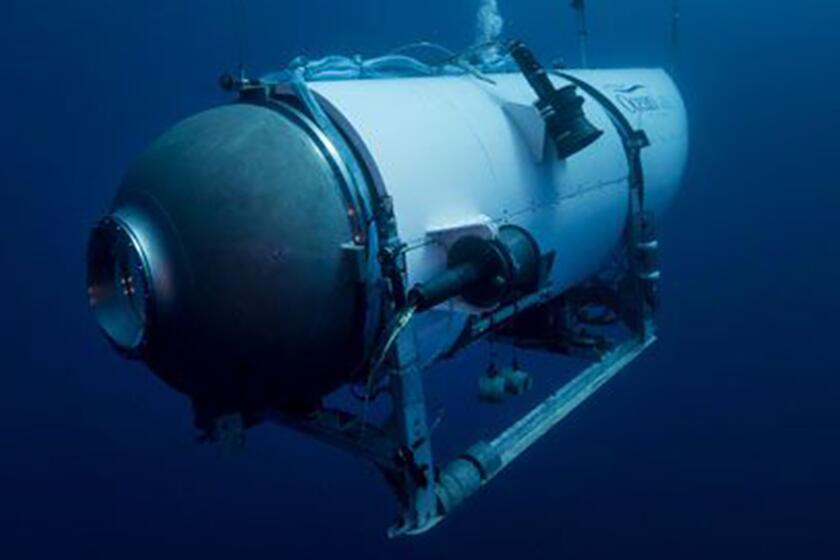
Entertainment & Arts
Commentary: As those aboard the Titan submersible suffered, social media laughed
The exploitative coverage of the death and terror unfolding in real time as the search for the Titan sub continued was compounded by the public’s reaction on TikTok and Twitter.
OceanGate has been running expeditions with “citizen explorers” to the Titanic since 2021 on its Titan sub, according to its website. But as the search unfolded, new details emerged that submersible industry leaders, oceanographers and former employees had long sent warning signs about the Titan.
The Manned Underwater Vehicles Committee at the Marine Technology Society, which advocates for marine technology and resources, wrote a private letter to Rush in 2018 calling on him to allow for a third-party safety review of the Titan. The letter said the marketing for the Titan was, “at minimum, misleading to the public and breaches an industry-wide professional code of conduct we all endeavor to uphold.”
“Our apprehension is that the current experimental approach adopted by OceanGate could result in negative outcomes (from minor to catastrophic) that would have serious consequences for everyone in the industry,” the letter stated.
That same year, David Lochridge, a former OceanGate employee, raised red flags about the Titan in litigation against the company, “particularly OceanGate’s refusal to conduct critical, non-destructive testing of the experimental design of the hull.”
Lochridge, a submersible pilot hired to do quality and safety inspections, said he was terminated for coming forward. He said he disagreed with Rush’s decision to “subject passengers to potential extreme danger in an experimental submersible.” In court papers, OceanGate denied Lochridge’s claims, and the case was later settled.
Rush had criticized what he considered red tape. “One of the jabs that gets thrown at us is: ‘Hey, you aren’t certified.’ But how can you do something new and get certified?” Rush asked in a 2022 article in Maptia. “If the rules exist for how to do it, then you are operating outside of the rules by doing something different.”
Referring to Gen. Douglas MacArthur, he added: “I think it was MacArthur who said, ‘You are remembered for the rules you break.’ We try to break the rules intelligently and intentionally.”
Times staff writers Richard Winton and Noah Goldberg in Los Angeles contributed to this report.
More to Read

Divers discover wreckage and remains from U.S. Air Force crash off Japan
Dec. 4, 2023

5-year-old dies after she and a man are swept out to sea at Half Moon Bay. ‘Sneaker waves’ cited
Nov. 26, 2023

Mexico says four more sunken boats found in Acapulco bay after Hurricane Otis
Oct. 31, 2023
Start your day right
Sign up for Essential California for news, features and recommendations from the L.A. Times and beyond in your inbox six days a week.
You may occasionally receive promotional content from the Los Angeles Times.

Alexandra E. Petri is a former Los Angeles Times staff writer who covered trends and breaking news. She previously covered live news at the New York Times. A two-time reporting fellow with the International Women’s Media Foundation, she graduated from Penn State with a degree in journalism and international studies.
More From the Los Angeles Times

4 officers killed in N. Carolina were at disadvantage as shots rained from above, police say
April 30, 2024

U.S. drug control agency will move to reclassify marijuana in a historic shift

Qatar’s mediation efforts in Israel-Hamas war come under fire

Netanyahu vows to invade Rafah ‘with or without a deal’ for a cease-fire
Search Day 4: Titan submersible debris found, all onboard presumed dead
Coverage on this live blog has ended. Please click here for the latest updates.
All five people aboard the Titan submersible are believed to be dead, and debris discovered in the search area was consistent with a "catastrophic implosion," the U.S. Coast Guard said.
The debris was found off the bow of the sunken Titanic, officials said.
The search for the Titan, which went missing Sunday after it e mbark ed on a mission to survey the wreckage of the Titanic , had been focused on an area where Canadian aircraft detected "underwater noises" Tuesday and again yesterday.
U.S. Coast Guard officials had estimated the five passengers could run out of air just before 7:10 a.m. ET today, and the location of the missing vessel had remained a mystery even as the search intensified.
What to know about the search for the Titan
- The debris found at the seafloor was "consistent with a catastrophic implosion of the vessel," the Coast Guard said.
- The Coast Guard said today that a "debris field" had been found in the search area.
- The submersible disappeared Sunday during a mission to survey the wreckage of the Titanic, which is 900 nautical miles east of Cape Cod, Massachusetts.
- A sound consistent with an implosion was heard Sunday, shortly after the submersible lost communications, the a senior U.S. Navy official said. The sound was not definitive, the official said.
- Those on board have been identified as Stockton Rush, the CEO of OceanGate Expeditions, the company behind the mission; British billionaire Hamish Harding, the owner of Action Aviation; French dive expert Paul-Henri Nargeolet; and prominent Pakistani businessman Shahzada Dawood and his son, Suleman.
White House offers condolences to families of Titan victims
The Associated Press
The White House offered its condolences to the families mourning the five people killed aboard the Titan submersible.
U.S. Coast Guard officials announced their deaths Thursday following the vessel’s catastrophic implosion in the North Atlantic.
“Our hearts go out to the families and loved ones of those who lost their lives on the Titan,” the White House said in a statement. “They have been through a harrowing ordeal over the past few days, and we are keeping them in our thoughts and prayers.”
The statement also thanked the searchers, including the Coast Guard, involved in the international effort to find the submersible.
“This has been a testament to the skill and professionalism that the men and women who serve our nation continue to demonstrate every single day,” the statement said.
David Pogue on the misinformation and misunderstandings swirling around the Titanic sub
Kat Tenbarge
Tech journalist and “CBS Sunday Morning” correspondent David Pogue, who observed an OceanGate Expeditions Titanic shipwreck trip last year, the last before the Titan disappeared this week, said a “massive amount of misinformation” has circulated online this week.
In an interview, Pogue, whose coverage of the submersible last year has attracted renewed interest in light of the disaster, also responded to attacks on his reporting over the past two days.
Critics on Twitter have suggested that Pogue and other journalists undersold how dangerous the submersible was or even that he conspired to shield the company from accountability.
Pogue countered that the safety issues were the “centerpiece” of his OceanGate coverage. “There is a fundamental lack of understanding of the deep-sea diving industry process,” he said.
Read the full story here.
Paul-Henri Nargeolet 'knew the risks that were possible with this expedition,' stepson says
Tim Stelloh
Paul-Henri Nargeolet, a French diver and Navy veteran who died aboard the Titan, was “fearless” and understood the potential danger of traveling to the Titanic's wreckage, his stepson said in an interview.
"Anyone who gets into those submersibles knows the risks that could happen," stepson John Paschall said, adding: "Going into this, he knew the risks that were possible with this expedition."
Paschall described Nargeolet, who had led several expeditions to the sunken passenger ship and supervised the recovery of at least 5,000 artifacts, as “the world expert on the Titanic.”
The ocean, Paschall said, was Nargeolet’s “home away from home. He was just so comfortable out there and in any ocean and any lake or whatever it was. The water was just so connected to him.”
“And that especially goes for the Titanic,” Paschall said. “He put so much of his life into that ship.”
Paschall also recalled Nargeolet as a “really incredible stepfather” — someone who was respectful, loving and funny.
While Nargeolet knew the risks of traveling in a submersible, Paschall said, he wanted to know more about how the company that operated the boat, OceanGate, had maintained the vessel and whether it had kept passengers properly informed.
“Were all the safety procedures followed as closely as possible?” Paschall said. “Was everyone aware of everything that was going on? Was there anything that was missed during any kind of inspection?”
19-year-old Titan passenger was ‘terrified’ before trip, his aunt says
Daniel Arkin
In the days before the Titan vessel went into the ocean off Newfoundland, Canada, the 19-year-old university student accompanying his father on the expedition expressed hesitation about going, his aunt said in an interview Thursday.
Azmeh Dawood — the older sister of Pakistani businessman Shahzada Dawood — said her nephew, Suleman, informed a relative that he “wasn’t very up for it” and felt “terrified” about the trip to explore the wreckage of the Titanic.
But he ended up going aboard OceanGate’s 22-foot submersible because the trip fell over Father’s Day weekend and he was eager to please his dad, who was passionate about the lore of the Titanic, Azmeh Dawood said.
'We will miss him today and every day,' Paul-Henri Nargeolet's family say
Phil Helsel
The family of French dive expert Paul-Henri Nargeolet say they will remember him for the rest of their lives after he and four other people died in the Titan submersible accident.

Nargeolet was an “extraordinary father and husband,” the family said.
"He is a man who will be remembered as one of the greatest deep-sea explorers in modern history. When you think of the Titanic and all we know about the ship today, you will think of Paul-Henri Nargeolet and his legendary work," they said in a statement.
The statement added: "But what we will remember him most for is his big heart, his incredible sense of humor and how much he loved his family. We will miss him today and every day for the rest of our lives."
Nargeolet led several expeditions to the Titanic wreckage site, completing at least 35 dives in submersibles and supervising the recovery of at least 5,000 artifacts, including the recovery of the "big piece" — a 20-ton section of the Titanic’s hull — according to Experiential Media Group, where he was the director of underwater research.
The family thanked everyone involved in the dayslong rescue effort and extended condolences to the families of the others who died.
Hamish Harding remembered as an inspiration
The family of British billionaire Hamish Harding and his company are “united in grief” with the families of four other people all dead in the Titan submersible incident, Action Aviation said in a statement.
“Hamish Harding was a loving husband to his wife and a dedicated father to his two sons, whom he loved deeply. To his team in Action Aviation, he was a guide, an inspiration, a support, and a Living Legend,” the company said.
Harding, a former pilot and explorer, was inducted as a Living Legend of Aviation last year, Action Aviation said.
Family of father and son killed in submersible ask for prayers
Antonio Planas
The family of the father and son who died in the Titan submersible are asking for prayers and said they found strength in rescue efforts.
Pakistani businessman Shahzada Dawood and his son, Suleman, were among the five people killed on the submersible that imploded.
“It is with profound grief that we announce the passing of Shahzada and Suleman Dawood," the family said in a statement released by the Dawood Foundation. "Our beloved sons were aboard OceanGate’s Titan submersible that perished underwater. Please continue to keep the departed souls and our family in your prayers during this difficult period of mourning.”
The family said they were grateful to the people involved in the rescue efforts, saying that "their untiring efforts were a source of strength for us during this time."
"We are also indebted to our friends, family, colleagues, and well-wishers from all over the world who have stood by us during our hour of need," the statement said. "The immense love and support we receive continues to help us to endure this unimaginable loss.”
The Dawood family also offered condolences to the families of the other people aboard the Titan.
Acoustic 'anomaly' consistent with implosion had been detected, Navy official confirms
Mosheh Gains
Courtney Kube
A U.S. Navy analysis of acoustic data “detected an anomaly consistent with an implosion or explosion” near the Titan around the time it lost communications, a senior Navy official said.
The sound consistent with an implosion was heard Sunday, shortly after the submersible lost communications, the official said.
The sound was not definitive, the official said, and it was immediately shared with commanders, who decided to continue searching.
“This information was considered with the compilation of additional acoustic data provided by other partners and the decision was made to continue our mission as a search and rescue and make every effort to save the lives on board,” the Navy official said.
The Wall Street Journal first reported that the sound had been detected.
'Titanic' director James Cameron sees similarities between sunken ship and submersible
“Titanic” director James Cameron said he was astonished by the similarities between the ship that sank in 1912 and the Titan submersible that imploded with five people aboard.
“I’m struck by the similarity of the Titanic disaster itself, where the captain was repeatedly warned about ice ahead of his ship, and yet, he steamed at full speed into an ice field on a moonless night. And many people died as a result,” Cameron said in an interview with ABC News.
“For a very similar tragedy, where warning signs went unheeded, to take place at the same exact site, with all the diving that’s going on all around the world … it’s just astonishing,” he added. “It’s really quite surreal.”
Cameron said submersible diving is a “mature art” and noted many people in the deep submergence engineering community wrote letters to OceanGate Expeditions, the company behind the mission, pleading that what the company was doing was “too experimental to carry passengers.”
The movie director said one of the passengers aboard the Titan, French dive expert Paul Henry Nargeolet, whom he called “PH,” was a friend he had known for 25 years. He said Nargeolet’s death “is almost impossible for me to process.”
Cameron said he's made 33 dives to the Titanic wreckage site and calculated he's “spent more time on the ship than the captain did back in the day.”
Cameron’s 1997 film starring Leonardo DiCaprio and Kate Winslet is among the highest-grossing movies of all time, raking in more than $2 billion.
Ocean depth will make recovering bodies from Titanic submersible difficult
'i hope this discovery provides some solace': coast guard's mauger.
Marlene Lenthang
The desperate search for the missing Titan has ended in tragedy after debris from the submersible was found and its five occupants were presumed dead.
“On behalf of the United States Coast Guard and the entire unified command, I offer my deepest condolences to the families," Rear Adm. John Mauger of the Coast Guard said this afternoon. "I can only imagine what this has been like for them and I hope that this discovery provides some solace, during this difficult time."
He said the unified command has been in contact with Britain and France, as the nations had citizens aboard the vessel.
5 major pieces of debris led to identification of Titan, officials say
Undersea expert Paul Hanken said five major different pieces of debris told authorities that it was the remains of the Titan.
“The initial thing we found was the nose cone, which was outside the pressure hull. We then found a large debris field, within that large debris field we found the front end bell of the pressure hull. That was the first indication that there was a catastrophic event,” he said.
A second, smaller debris field was also found, which included the other end of the pressure hull, “which basically comprised the totality of that pressure vessel,” Hanken said.
Teams on site will continue to map the debris field on the ocean floor.
Sonar buoys in search did not detect any implosion sounds
It's not clear exactly when the Titan imploded, but Coast Guard officials said that sonar buoys dispatched "did not hear any signs of catastrophic failure."
"This was a catastrophic implosion of the vessel which would have generated a significant broadband sound down there that the sonar buoys would have picked up," Rear Adm. John Mauger of the Coast Guard said at a news conference today.
Sonar buoys had detected noises in the water Tuesday and yesterday that were being assessed for patterns, but he said today "there doesn't appear to be any connection between the noises and the location [of the debris] on the sea floor."
Debris is consistent with a 'catastrophic implosion' of sub
The debris found at the sea floor was "consistent with a catastrophic implosion of the vessel," Rear Adm. John Mauger of the Coast Guard said.
When asked if it's possible the vessel collided with the Titanic, he said it was found off the bow of the Titanic.
Carl Hartsfield with the Woods Hole Oceanographic Institution said the debris data is consistent with an implosion in the water column.
" It's in an area where there's not any debris of the Titanic, it is a smooth bottom. To my knowledge ... there's no Titanic wreckage in that area and again 200 plus meters from the bow, and consistent with the location of last communication for an implosion in the water column," he said.
Dawood's older sister feels like she's been 'caught in a really bad film'
The older sister of Pakistani businessman Shahzada Dawood feels "absolutely heartbroken" that her brother and her 19-year-old nephew were aboard the Titan vessel.
"I feel very bad that the whole world has had to go through so much trauma, so much suspense," Azmeh Dawood said in a phone interview this afternoon, speaking from the home in Amsterdam she shares with her husband.
"I feel like I’ve been caught in a really bad film, with a countdown, but you didn’t know what you’re counting down to," she said, fighting back tears. "I personally have found it kind of difficult to breathe thinking of them."
Azmeh claimed that her nephew did not want to go on the submarine but agreed to take part in the expedition because it was important to his father, a lifelong Titanic obsessive. Suleman "wasn't very up for it" and "terrified," she claimed, explaining that the 19-year-old expressed his concerns to another family member.
"If you gave me a million dollars, I would not have gotten into the Titan," she said.
Tail cone of Titan found 1,600 feet from bow of the Titanic floor, Coast Guard says
“This morning, an ROV from the vessel Horizon Arctic discovered the tail cone of the Titan submersible approximately 1,600 feet from the bow of the Titanic on the sea floor," Rear Adm. John Mauger, said this afternoon.
Afterward, the ROV found additional debris and it was found to be consistent with the "the catastrophic loss of the pressure chamber," he said.
The families of the five crew members on board were notified afterward.
OceanGate says those aboard sub have 'sadly been lost'
OceanGate issued a statement moments ago on the status of the sub:
"We now believe that our CEO Stockton Rush, Shahzada Dawood and his son Suleman Dawood, Hamish Harding, and Paul-Henri Nargeolet, have sadly been lost.
"These men were true explorers who shared a distinct spirit of adventure, and a deep passion for exploring and protecting the world’s oceans. Our hearts are with these five souls and every member of their families during this tragic time. We grieve the loss of life and joy they brought to everyone they knew.
"This is an extremely sad time for our dedicated employees who are exhausted and grieving deeply over this loss. The entire OceanGate family is deeply grateful for the countless men and women from multiple organizations of the international community who expedited wide-ranging resources and have worked so very hard on this mission.
"We appreciate their commitment to finding these five explorers, and their days and nights of tireless work in support of our crew and their families. This is a very sad time for the entire explorer community, and for each of the family members of those lost at sea. We respectfully ask that the privacy of these families be respected during this most painful time."
Rush 'got unlucky,' friends say
Elizabeth Chuck
Rush, the OceanGate executive who is on board the missing Titan submersible with four other people, is an intelligent explorer who is adept at managing risk, according to longtime friends.
Rush is "one of the most risk-averse people I know,” said Guillermo Söhnlein, who co-founded OceanGate.
Söhnlein said he last spoke with Rush about two weeks before the Titan’s expedition, its third to the Titanic site. Rush did not express any worries about the upcoming voyage.
“If anything, it’s the other way around,” Söhnlein said. “Any explorer will always tell you that on every expedition, on every mission, on every dive, something always goes wrong. You have to anticipate that something is going to go wrong. And the more guides you conduct, the more missions you conduct, the more expeditions you do, the more you start limiting those things.”
Another friend, oceanographer Gregory Stone, said Rush was upfront about the dangers of his missions.
“He wasn’t selling tickets like it was Disneyland. He was telling people exactly what it was — it was a dangerous thing,” Stone said. “He had taken every precaution possible, and he got unlucky. Something happened.”
Pakistani businessman is not a 'risk-taker,' friend says
Dawood, the Pakistani businessman aboard the Titan, is a "quiet and unassuming" person and not a "daredevil" by nature, according to one of his friends.
"I think he would want his legacy and his memory to be one where ... he wouldn't want to be seen as some daredevil, risk-taking explorer," said Bill Diamond, the chief executive of the SETI Institute, a California-based organization that searches for signs of extraterrestrial life. (Dawood is on the group's board of trustees.)
"I think he would want to be remembered as a humble businessman, curious about the world and fascinated by the opportunity to take this excursion and be on this expedition," said Diamond, who spoke to NBC News via Zoom.
Diamond said he believed Dawood would never do anything that would jeopardize the life of his 19-year-old son, Suleman, who is also aboard the Titan.
"I'm sure he would not have brought his son along if he thought this was something seriously dangerous," Diamond said. "I think he knew the risks, at the same time I think he felt that the technology was tried and tested and safe enough."
Coast Guard says 'debris field' found in Titan search area
The Coast Guard said in a tweet at 11:48 a.m. ET that a remotely operated vehicle discovered a "debris field" in the Titan vessel search area.
"Experts within the unified command are evaluating the information," the agency said.
Officials are planning to hold a news briefing at 3 p.m. ET.
Search is a 'needle in a haystack,' expert says
While remaining realistic about the chances of finding the Titan on the vast ocean floor, scientists are still offering a glimmer of hope.
Rob Larter, a marine geophysicist with the British Antarctic Survey, said in London today that it’s incredibly difficult to find an object the size of the Titan in a totally dark environment. He says it’s not going to be found with active sonar from a surface ship, but rather with a towed or autonomous vehicle that’s near the seafloor. Even those vehicles can see just a matter of meters.
“I’ve been involved in searches for hydrothermal vent sites,” he said. “We’ve had the vehicles just a few tens of meters away and missed them and then come back and find them. So it really is, you know, literally it’s just a needle in a haystack situation unless you’ve got a pretty precise location”
Jamie Pringle, an expert in forensic geosciences at Keele University in the United Kingdom, says the first 24 hours are critical in these kinds of rescue operations and that time period has long passed.
“So there’s always a chance. It’s never zero. But I think obviously the longer the time elapses, the lower the chance of success,” he said.
Larter called it a “desperate situation” buy says you try to stay optimistic as long as possible.
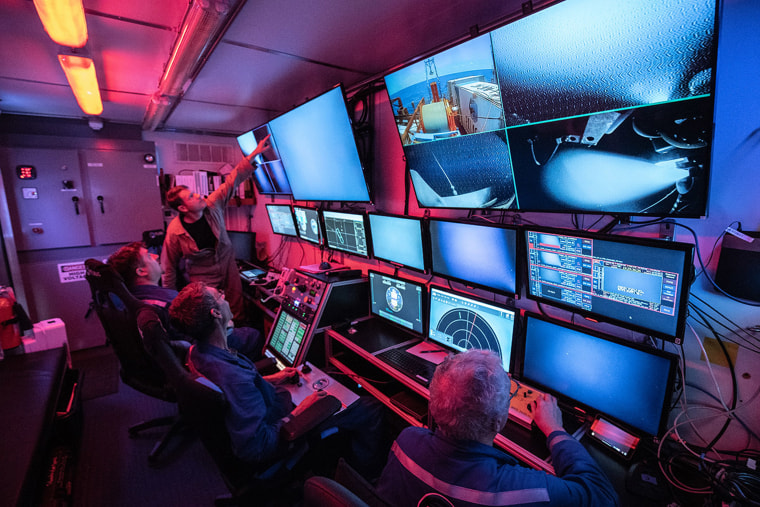
“It’s kind of unimaginable if people are alive, trapped in a submersible with oxygen supplies running down,” he said.
Chance of finding survivors 'close to zero,' retired Navy captain says
Corky Siemaszko
With the trapped Titan passengers likely out of oxygen, David Marquet, a retired Navy captain, said today "the probability is perilously close to zero that we will be able to recover them alive."
The Titan had 96 hours worth of oxygen, he told NBC News' Tom Costello.
"Things generally work up to the design spec, but they don’t somehow magically last beyond the design spec," Marquet said, referring to the oxygen estimates.
Dawood's friend says his death would be 'a tremendous loss for the world'
Ammad Adam met Shahzada Dawood at a United Nations conference in February 2020. Dawood gave a speech about empowering women and girls in Pakistan, and Adam was impressed by his remarks. The two kept in touch over the last three years, striking up a friendship via Facebook.
Adam, 34, is now "praying for a miracle" and hoping that Dawood and the four other passengers aboard the Titan will be found alive.
"I can tell you that Shahzada was a real great gentleman, a fine gentleman," he said. "I know everyone says, 'Oh, such and such is a good person,' but he's actually a genuinely kind-hearted person and you could see that in his actions."
Adam said Dawood dedicated much of his adult life to charitable activity, including donating to Covid relief funds in the early days of the pandemic.
"I hope for a miracle from God," Adam said, "because his death would be a tremendous loss for the world. He tries to help people who need help, and we need more people like that."
Teen trapped in missing sub is U.K. business school student
Henry Austin
The youngest of the five people aboard the missing submersible had just completed his first year at the Strathclyde Business School in the Scottish city of Glasgow.
The University of Strathclyde said in a statement that it was “deeply concerned” about Suleman Dawood, 19, “his father and the others involved in this incident.”
“Our thoughts are with their families and loved ones and we continue to hope for a positive outcome,” the statement added.
Weather at site is 'pretty good' for search, marine forecaster says
Julianne McShane
Weather at the scene of the search consists of winds blowing at 14 mph with gusts up to 19 mph, according to a tweet from the Coast Guard , which added that there are 4 to 5 foot swells in the water and the air temperature is about 50 degrees Fahrenheit.
Chris Parker, president and chief forecaster at Marine Weather Center , described those conditions as "pretty good," adding that they are mild to moderate for the area, which he said normally experiences higher waves and stronger winds of 30 to 40 knots on the Beaufort Wind Scale .
"An average 30-foot sailboat would be happy in those conditions unless they're going into the wind," he told NBC News of the conditions today.
"Those conditions should not be at all problematic" for the search, he added.
'A lot of the systems worked, but a lot of them really didn’t,' says Discovery Channel host who tested out the Titan
Josh Gates, the host of Discovery Channel’s "Expedition Unknown," told CNN's Anderson Cooper on Wednesday that he tested out the Titan for a possible segment for his show in 2021 and that "a lot of the systems worked, but a lot of them really didn’t" at the time.
"In the course of going out on Titan and diving down inside of it, it just became clear to us at that time that there was a lot that still needed to be worked out with the sub," he said on "Anderson Cooper 360."
"Ultimately, I just felt by the end of that trip that I just couldn’t get comfortable with Titan at that time. I felt that it needed time to go out and do missions and kind of get into a groove before we were going to go and film with it," Gates added.
Gates said the Titan offers a more comfortable fit inside compared to other submersibles due to the carbon fiber i t is partially made out of , allowing it to be larger than other subs that can only fit two to three people.
"On the one hand you have this incredibly innovative, novel design; on the other hand there are a lot of unknowns," he said of the Titan, adding that it has been “very surreal” and “haunting” to watch the search for the missing submersible.
OceanGate CEO has personal connection to famous Titanic victims
Rush, who developed and piloted the missing sub, had a ''pressing need'' to document the Titanic’s watery graveyard — but he had a personal connection to the wreck, as well.
His wife, Wendy Rush, is a great-great-granddaughter of two of the Titanic’s best-known victims, Isidor and Ida Straus.
Isidor Straus was the co-owner of the Macy’s department store. His wife, Ida, refused to be separated from him when the Titanic started sinking, giving up her own seat on a lifeboat to stay with him on board. Survivors recount seeing them arm in arm on the ship’s deck as it went down.
Their fate aboard the Titanic was portrayed in James Cameron’s movie, in which an elderly couple choose to spend their last moments in bed together as water comes rushing onboard. Theirs has been remembered as a '' love story for the ages .''
According to the Straus Historical Society, Wendy Rush is the daughter of Dr. Richard Weil III, who is the son of Richard Weil Jr., a former president of Macy’s New York. Weil Jr. is the son of Minnie Straus, Isidor and Ida’s daughter.
Wendy Rush, née Weil, married Rush in 1986, according to a New York Times wedding announcement .
A tale of two disasters: Missing sub captivates the world days after deadly migrant shipwreck
Chantal Da Silva
As rescuers raced to find the five people who vanished after launching a mission to survey the Titanic, another disaster at sea that’s feared to have left hundreds of people dead has been swept from the spotlight.
Last week’s sinking of a fishing boat crowded with migrants trying to get from Libya to Italy sparked arrests, violent protests and questions about authorities’ failure to act or find a long-term solution to the issue. But many human rights advocates are frustrated that the world seems to have already moved on and that the resources and media attention being dedicated to the Titan rescue efforts far outweigh those for the sunken migrant ship.
“It’s a horrifying and disgusting contrast,” Judith Sunderland, associate director for Human Rights Watch’s Europe and Central Asia division, said in a telephone interview, reflecting on the apparent disparities in resources and media attention on the two crises.
“The willingness to allow certain people to die while every effort is made to save others ... it’s a, you know, really dark reflection on humanity,” she said.
Senior British submariner helps with search
Alexander Smith
The British government said today it has dispatched one of its senior submariners, Lt. Cmdr. Richard Kantharia, to assist with the rescue mission.
Kantharia was already embedded in the U.S. Atlantic submarine fleet and joined the rescue effort Tuesday, a spokesperson for No. 10 Downing St. said by email.
Britain is also providing a Boeing C-17 Globemaster aircraft to transport equipment involved with the search.
Dawood family says 'sole focus' is on rescue of father and son
Sabrina Dawood, the sister of Shahzada Dawood, 48, one of the five people on board the Titan along with his 19-year-old son, Suleman, told Sky News in a Facebook message yesterday that "the Dawood family’s sole focus is the rescue of our beloved Shahzada and Suleman Dawood."
"We trust that the family will be granted privacy as we deal with this crisis," she said.
She added the family is also "deeply grateful" for news organizations' "constant coverage" of the missing submersible, but that they "are unable to address any questions or comments at the moment."
Searchers will need to 'get very, very lucky' to find sub, expert says
Simon Boxall, who teaches oceanography at England's University of Southampton, laid out in stark terms the daunting task facing those trying to find the cylindrical vessel. "The only way they are going to succeed is to get very, very lucky," he told NBC News by telephone early today.
On land, he explained, officials would have an array of tools at their disposal, from GPS and infrared tech to old-fashioned binoculars. "Underwater, that all goes out of the window," said Boxall, who believes given the extensive search by air that it's unlikely the craft is still bobbing around on the surface.
One way to scour the seabed is to send a robotic submersible down there with a light and a camera. That would be like going to an area twice the size of Connecticut "with a flashlight and just having a look around for something this small — it’s a big, big task,” he said.
Officials are also relying on sonar: bouncing sound off the seabed to create an image of what's down there, a painstaking task that Boxall likened to painting the Golden Gate Bridge "with a child's paintbrush."
If it lost power, the submersible likely drifted down to the seabed, traveling up to 15 miles on strong, deep-ocean currents that take water all the way to Antarctica, he said. Compounding that, this area is "very bumpy" and there is "this great big thing called the Titanic, which sank in the area, scattering all kinds of things far and wide."
Magellan ROV to assist in today's search efforts
The Magellan “working class” remotely operated vehicle, or ROV, will assist in the day’s search , Rear Adm. John W. Mauger of the Coast Guard said on NBC’s “TODAY” show.
A working class ROV has a manipulator arm that can attach to a hull point and potentially lift it off the surface, Explorers Club President Richard Garriott previously told NBC New York in an interview.
The Explorers Club, a society dedicated to scientific exploration and field study that two Titan passengers — Harding and Nargeolet — are part of, previously criticized the Coast Guard for not permitting the use of the Magellan ROV earlier.
Responding to the criticism, Mauger said: “We really had to start from scratch and bring all the capability that was available to bear on this problem,” adding that officials “made decisions to prioritize” what was closest to the site.
Coast Guard will 'continue with the search and rescue efforts'
Rear Adm. John W. Mauger said on the "TODAY" show that the Coast Guard is "going to continue with the search and rescue efforts" throughout the day despite fears of the oxygen supply on the vessel running out.
"We use all available data and information to prosecute those searches but we continue to find particularly in complex cases that peoples' will to live really needs to be accounted for as well," he said.
Mauger added that "teams were working really hard through the night" and that medical personnel were also moving into the site today.

Two more ROVs deployed
The Horizon Arctic, a Canadian-flagged ship, which is helping with the search and rescue mission, has deployed its remotely operated vehicle, or ROV, which is now on the seabed, the Coast Guard said on Twitter .
Meanwhile, the French government-backed vessel L'Atalante is about to deploy its own ROV, Victor 6000, into the ocean, the Coast Guard said .
Coast Guard's estimated time for oxygen running out reached
It's now 7:08 a.m. ET, the time that the Coast Guard estimated the oxygen on the missing submersible could run out.
The exact situation onboard the vessel, which had 96 hours of oxygen when it set off, according to its specs and Coast Guard officials, is not known.
Experts have pointed out that there are a number of variables that could impact the consumption of oxygen onboard.
"There are so many variables," Simon Boxall, who teaches oceanography at England’s University of Southampton, told NBC News. “We have no idea how long they will actually last in terms of oxygen — all that we know is that it’s imminent.”
Social media users tracking marine traffic in search area via satellite
As the search for the submersible stretched into today, some social media users said they were following the effort and tracking marine traffic in the area via satellite.
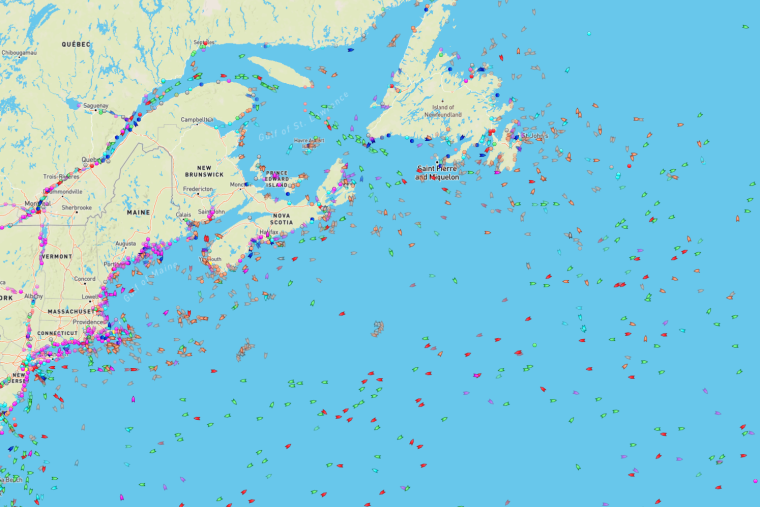
"Never in my life would I have thought I’d be awake at 2:50am watching ships, on satellite, looking for billionaires stranded in a sub, AT the Titanic in 2023 but here I am refreshing Twitter again," one user tweeted , writing that the person was using the app MarineTraffic .
"I’ve been checking periodically all night," one user responded just after 4:30 a.m. ET.
"Haven’t been able to tear myself away from the computer for days now," another wrote .
The MarineTraffic app announced yesterday it was “making all positional data, including satellite positions, available for free for the Polar Prince in the ongoing search & rescue mission.”
Impossible to know exactly how much oxygen left in sub, expert says
The Coast Guard predicts the oxygen supply on the submersible will run out at around 7:08 a.m. ET today. But it doesn't quite work like that, according to Simon Boxall, who teaches oceanography at England's University of Southampton.
"There are so many variables," Boxall told NBC News. "We have no idea how long they will actually last in terms of oxygen — all that we know is that it's imminent." One of the main factors governing the rate of oxygen consumption is the physical state of those on board. If their bodies start to shut down due to hypothermia, Boxall said, it would mean "they're using a lot less oxygen" — albeit presenting a new danger for the crew.
Although the Coast Guard has presented this timeline, officials know about these variables, according to Boxall. "It's not like" at 7.08 a.m. the rescuers will "pack up their bags and say, 'Right, we'll do a recovery operation, but we're taking the urgency off," he said. "They will still see this as being very urgent for next couple of days."
2 new vessels arrive on scene, conducting search patterns
Two new vessels have arrived on the scene and are conducting search patterns in the bid to find the Titan, a Coast Guard spokesperson said this morning.
The Canadian CGS Ann Harvey and the Motor Vessel Horizon Arctic, a remotely operated vehicle, or ROV, arrived to aid in the bid to find the missing submersible, Petty Officer Ryan Noel said.
The Coast Guard had previously said the two vessels were en route to the search site.
Noel said rescuers were also in the process of trying to get “one of the newer ROVs onsite down there." He could not confirm which ROV that was, but said the Coast Guard would be providing updates as more information became available.
Search patterns show more sea scanned in bid to find the Titan
The Coast Guard released a new image yesterday showing search patterns so far as efforts expanded in the race to find the missing sub.
It also released search patterns Tuesday, with the difference depicted below.

Searchers had covered an area twice the size of Connecticut on the surface, and the search underwater is about 2 ½ miles deep, officials said yesterday.
Ex-senior naval officer has 'no optimism' about underwater noises
The search and rescue mission was given fresh hope after a Canadian aircraft detected "underwater noises" on Tuesday and yesterday. But Chris Parry, a former rear admiral in the British Royal Navy, says he isn't greatly encouraged.
"I've got no optimism about that at all," Parry told NBC News. "Put your head in the water, you’re going to hear a lot of mechanical noises, particularly in the vicinity of a disintegrating wreck like the Titanic."
He called the optimism "clutching at straws."
The Titanic brought them together, and a tiny vessel could doom them
The five-person crew rescuers are racing to find went missing after departing on a mission Sunday morning from the Polar Prince, a Canadian research vessel, to survey the Titanic firsthand.
The passengers are now at the center of a much higher-stakes race against the clock — a frantic international search and rescue effort that must succeed before the 22-foot vessel runs out of oxygen this morning.
The passengers are Rush, who lives in Seattle and served as the vessel’s pilot; Harding, a British tycoon who lives in the United Arab Emirates; Dawood and his son, Suleman, scions of a Pakistani business dynasty; and the French mariner and Titanic expert Nargeolet, who has been nicknamed “Mr. Titanic.”
The men are likely bound together forever, no matter what happens next.
French deep sea robot arrives to join search
Due to join the hunt today was Victor 6000, an undersea robot dispatched by the French government that has the rare ability to dive deeper than the Titanic wreck.
The French research vessel L'Atalante, which is carrying the robot, has now arrived in the same area as other ships involved in the search as of 4 a.m. ET., according to the tracking website Marine Traffic.
Victor 6000 is so named because it can dive to 6,000 meters — some 20,000 feet. That puts the Titanic, 12,500 feet down, easily within its range.
It's familiar territory for Ifremer, the state-run French ocean research institute that operates the robot and was part of the team that first located the Titanic wreck in 1985. The institute dispatched the remotely operated vehicle, or ROV, this week at the request of the U.S. Navy.
It isn't able to lift the missing submersible own its own, but it could hook up the 10-ton carbon-fiber and titanium tube to another ship capable of bringing it to the surface, Olivier Lefort, the head of naval operations at Ifremer, told Reuters. “This is the logic of seafarers. Our attitude was: We are close, we have to go,” he said.
Desperate search for sub as oxygen supply dwindles
The search for the missing submersible grew more frantic this morning, with officials fearing the oxygen supply on the vessel could soon run out.
Coast Guard officials estimated that the Titan, which had a 96-hour oxygen supply, could run out of air just before 7:10 a.m. ET, but the exact situation onboard the vessel, including potential efforts to conserve oxygen, is not clear.
The search for the sub, which went missing Sunday after embarking on a mission to explore the Titanic, has been focused on an area where Canadian aircraft detected “underwater noises” Tuesday, and again yesterday.
- Search Please fill out this field.
- Manage Your Subscription
- Give a Gift Subscription
- Newsletters
- Sweepstakes
- Human Interest
Who Is on the Missing 'Titanic'-Bound Sub? All About the Passengers
The 'Titanic'-bound submersible included five passengers, including an operator and four mission specialists
:max_bytes(150000):strip_icc():format(webp)/thumbnail_IMG_3961-bc225863271e4083a2114cd444edc707.jpeg)
OceanGate has given a new update on the five passengers aboard the Titan , a Titanic -bound submersible , after it went missing on June 18.
On June 22, the company shared a statement with PEOPLE announcing that the five people onboard the missing submersible are believed to have died.
"We now believe that our CEO Stockton Rush, Shahzada Dawood and his son Suleman Dawood, Hamish Harding, and Paul-Henri Nargeolet, have sadly been lost," the company said in a statement.
"These men were true explorers who shared a distinct spirit of adventure, and a deep passion for exploring and protecting the world’s oceans. Our hearts are with these five souls and every member of their families during this tragic time. We grieve the loss of life and joy they brought to everyone they knew," the statement continued.
Operated by OceanGate Expeditions, the submersible first set out on Sunday morning, June 18. However, nearly two hours into the dive, the crew of the Canadian expedition vessel Polar Prince lost contact with the submersible, per the United States Coast Guard. A search for the Titan began shortly after .
During a press conference held on June 20, United States Coast Guard Captain Jamie Frederick confirmed there were five passengers on board, including an operator and four mission specialists.
EVARISTO SA/AFP via Getty; Victoria Sirakova/Getty; OceanGate
Among them included Shahzada Dawood, who worked with the Prince’s Trust International and The British Asian Trust, set up by King Charles, and French diver Paul-Henry Nargeolet, who had a long-standing history with the Titanic.
Here’s everything to know about the passengers of the Titan .
Hamish Harding
Victoria Sirakova/Getty
British businessman Hamish Harding was on board; he previously shared on Instagram on June 17 that he would be a part of the trip.
Harding was a British businessman and pilot based in the United Arab Emirates. He previously told Business Aviation Magazine that he grew up in Hong Kong with his parents before qualifying as a pilot in the mid-1980s while studying at Cambridge University.
The owner of global sales company Action Aviation, Harding had been on several explorations over the years, including visiting the South Pole several times ( once with Buzz Aldrin ) and going to space as part of the suborbital Blue Origin NS-21 mission in June 2022.
Shortly after the Titan went missing, Harding’s stepson Brian Szasz, from his wife’s previous relationship, confirmed that Harding was aboard the vessel as he asked for “thoughts and prayers” in a since-deleted post.
Szasz later shared a series of emotional videos on his Instagram Story on June 22, just hours before the vessel’s breathing air supply was expected to run out.
Shahzada and Suleman Dawood
SETI Institute
Pakistani businessman Shahzada Dawood and his son Suleman Dawood were both aboard the submersible, their family and King Charles' Prince’s Trust International confirmed to PEOPLE on June 20.
Shahzada was a trustee at the SETI Institute , a non-profit research organization on life and intelligence in the universe. Per his bio on the website, he “has an M.Sc. in Global Textile Marketing from Philadelphia University, USA, and an LLB from Buckingham University, UK.” The website also states that Shahzada, a British citizen, lived "in the UK with his wife, Christine, his children Sulaiman and Alina” as well as their dog and cat.
He also worked with the Prince’s Trust International and The British Asian Trust, set up by King Charles.
“Prince’s Trust International has a longstanding relationship with Shahzada Dawood and his family,” DEO Will Straw said in a statement. “We are shocked by this awful news, praying for a rescue and sending our thoughts to his family during this deeply challenging time.”
Paul-Henry Nargeolet
JOEL SAGET/AFP via Getty Images
French diver Paul-Henry Nargeolet was also on board.
Born in Chamonix, France, Nargeolet lived in Africa for 13 years with his family before returning to France to complete his studies. Afterward, he joined the French Navy where he eventually became a Commander before retiring in 1986 after 22 years of service.
Nicknamed “Mr. Titanic,” Nargeolet had a long history with the vessel as he was part of the first expedition to visit it in 1987, and had visited it many times since. He also served as the Director of Underwater Research for E/M Group and RMS Titanic, Inc.
Per his bio on E/M Group , “P.H. has led several expeditions to Titanic, completed 37 dives in the submersible himself, and supervised the recovery of 5,000 artifacts, including the recovery of the “big piece” a 20-ton section of Titanic’s hull (now on display in Las Vegas).”
During a 2019 interview with the Irish Examiner , Nargeolet discussed his involvement with the Titanic wreckage and whether he ever got scared traveling so far down in the ocean.
“If you are 11m or 11km down, if something bad happens, the result is the same,” he told the outlet at the time. “When you’re in very deep water, you’re dead before you realize that something is happening, so it’s just not a problem.”
Stockton Rush
OceanGate CEO and co-founder, Stockton Rush, was among the five passengers aboard the submersible “as a member of the crew.”
In addition to being the CEO of OceanGate, Rush is the co-founder and member of the Board of Trustees of OceanGate Foundation, “a non-profit organization which aims to catalyze emerging marine technology to further discoveries in marine science, history, and archaeology,” per the company’s website .
The website adds that before founding OceanGate, “Rush became the youngest jet transport rated pilot in the world when he obtained his DC-8 Type/Captain’s rating at the United Airlines Jet Training Institute in 1981 at the age of 19.”
Additionally, he served as a DC-8 first officer while studying mechanical and aerospace engineering at Princeton University , before joining the McDonnell Douglas Corporation as a Flight Test Engineer on the F-15 program in 1984.
A previous Princeton feature on Rush reported that he went on “every one of OceanGate’s dives.” In the feature, he also spoke excitedly about the Titanic expeditions. “Part of what we do is get people to appreciate that most of human history is underwater,” he said.
“If you think about it from an archeological perspective, if you had a caravan of precious items — records, books, gold, or whatever — and you were snowed in on the passes of Mongolia, all that stuff got stolen, pillaged. If you were in a ship carrying King Herod’s possessions to Rome and you sank, [it’s] still there.”
Rush's wife Wendy Rush — who is director of communications at OceanGate — is also the great-great-granddaughter of Isidor and Ida Strauss , two first-class passengers who died when the Titanic sank in 1912, according to archival records cited by The New York Times .
Related Articles
- International

University protests

Trump's hush money trial
June 19, 2023 - Search mission underway for missing Titanic tour submersible
By Elise Hammond , Maureen Chowdhury and Mike Hayes, CNN
Missing submersible lost contact with crew 1 hour and 45 minutes into descent, Coast Guard says
From CNN’s Celina Tebor and Gabe Cohen
The missing submersible near the Titanic wreckage lost contact with a crew 1 hour and 45 minutes into its descent Sunday morning, according to the US Coast Guard .
The 21-foot submersible was carrying five people, the Coast Guard tweeted .
The submersible lost contact with the crew of Polar Prince, the vessel used to transport it to the site of the Titanic wreckage before the expedition, according to the Coast Guard.
Chief Mi’sel Joe of Miawpukek First Nation, which co-owns the Polar Prince, said he received a call Sunday afternoon from the CEO of Horizon Maritime alerting him that the submersible was two hours overdue and hadn’t surfaced.
He was told communication with the sub was lost as it was going down to the wreckage. At that point, he says, requests for search and rescue had gone out.
“There’s a tremendous amount of concern,” Chief Mi’sel Joe said. “I have anguish that people are going through this. I wish there was more I can do.”
A trip on Titanic wreckage expedition costs "from $250,000," according to operator website
From CNN's Eric Levenson
The expedition to explore the wreckage of the Titanic costs passengers "from $250,000," according to an archived version of the company's website, accessible via the Internet Archive’s Wayback Machine .
OceanGate Expeditions, the company that operates the tour, advertised the experience as a way "to step outside of everyday life and discover something truly extraordinary.”
There, up to five people, including a pilot, a “content expert” and three paying passengers, board the submersible named “Titan” and descend to the bottom of the ocean.
“Once the submersible is launched you will begin to see alienlike lifeforms whizz by the viewport as you sink deeper and deeper into the ocean. The descent takes approximately two hours but it feels like the blink of an eye,” the website said.
According to OceanGate, the Titan is a 23,000-pound submersible made of carbon fiber and titanium.
As a safety feature, the sub uses a “proprietary real-time hull health monitoring (RTM) system” that analyzes the pressure on the vessel and the integrity of the structure, the company states. It also has life support for a crew of five for up to 96 hours, the website states.
5 people missing on submersible near Titanic wreckage, US Coast Guard says
From CNN’s Raja Razek
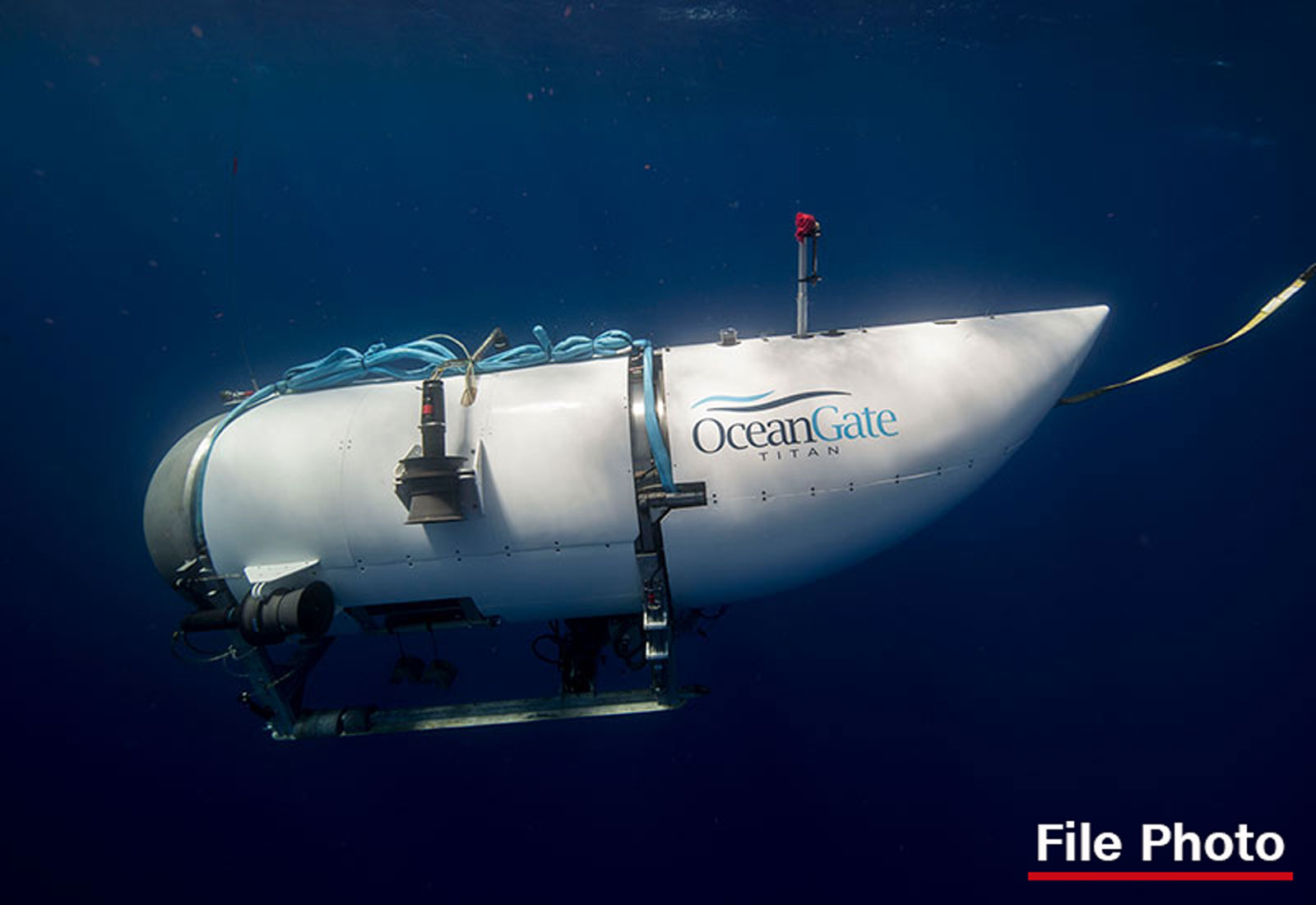
The US Coast Guard is searching for five people aboard a missing submersible near the Titanic wreckage, a spokesperson told CNN on Monday.
The Coast Guard received the first phone call about the missing submersible on Sunday, US Coast Guard Boston Public Affairs Officer Lieutenant Samantha Corcoran told CNN.
“There are five people we are searching for,” Corcoran said, adding that she does not know the specifics of all five people.
According to an archived version of the website run by the tour operator, OceanGate Expeditions – accessible via the Internet Archive’s Wayback Machine – the submersible holds up to five people: a pilot, a “content expert” and three paying passengers.
There are two aircraft and a ship on the scene searching, Corcoran said.
One aircraft is a Coast Guard C-130, and the second is a P-8 Poseidon aircraft from RCC Halifax, which is able to search and detect submarines underwater.
A Canadian Coast Guard ship is en route to the area as well, according to Corcoran.
Some background : The eight-day expedition is based out of St. John’s, Newfoundland, Canada, with a maximum of six people. The trip begins with a 400-nautical-mile journey to the wreck site.
There, up to five people, board the submersible named “Titan” and descend to the bottom of the ocean.
Vessel that carried submersible to Titanic site is 1 of 3 ships involved in search and rescue
From Gabe Cohen
Polar Prince, a vessel used to transport the missing submersible to the site of the Titanic wreckage before the expedition, is now assisting with the search and rescue efforts, a spokesperson for Horizon Maritime, a co-owner of the ship, told CNN.
Polar Prince is a former Canadian Coast Guard icebreaking ship, the company said.
Horizon Maritime says it has also dispatched an additional vessel, the Horizon Arctic, to assist. The company’s website says the Horizon Arctic is “designed and equipped for advanced offshore support operations.”
Canadian Joint Rescue Coordination Centre (JRCC) Halifax dispatched a third vessel — the Canadian Coast Guard Ship Kopit Hopson 1752 — to help in the search and rescue operation, it told CNN.
Member of Titanic expedition posted photos of the submersible before it launched on Sunday
From CNN’s Paul P. Murphy
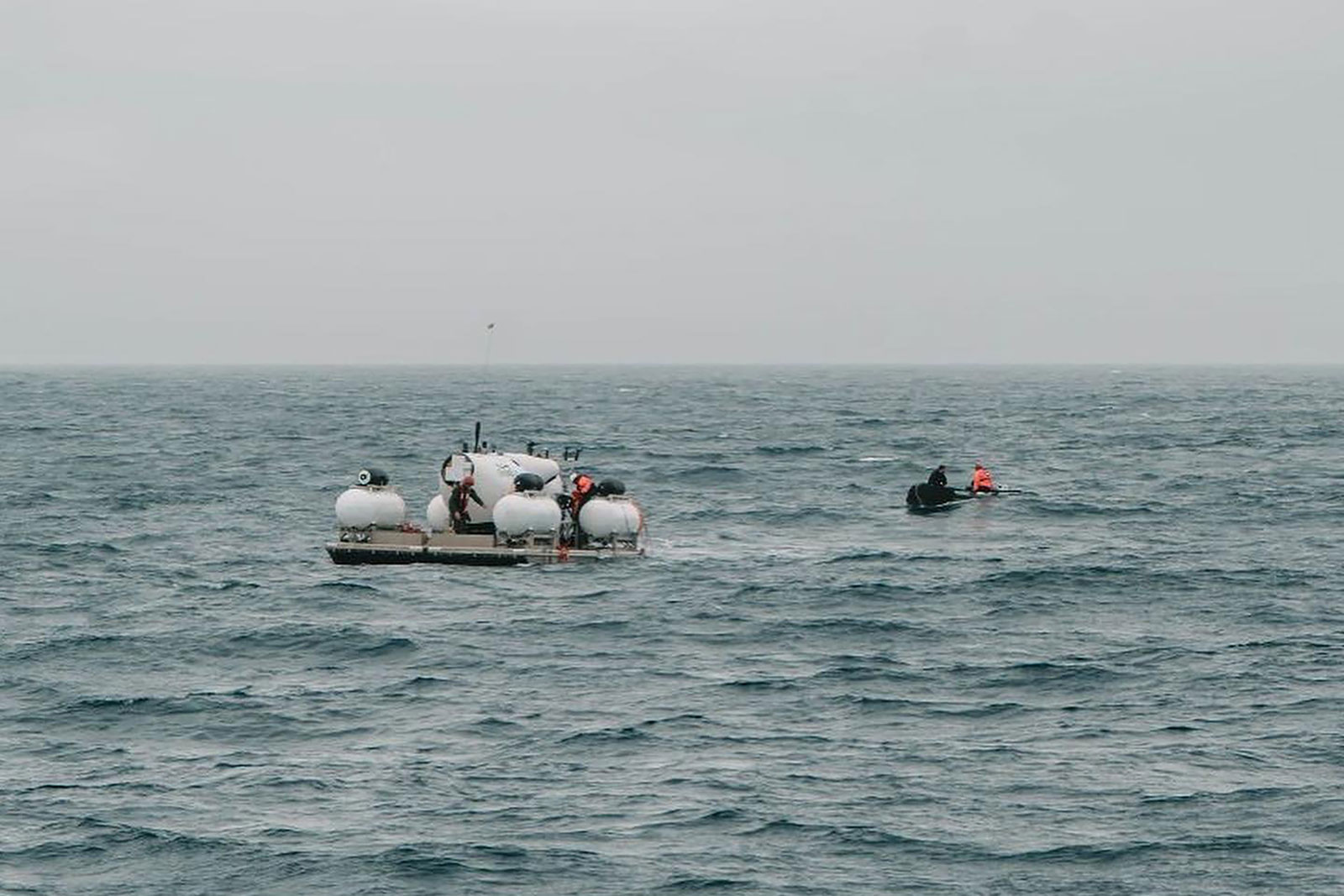
One of the people on the missing submersible posted photos of the vessel on Sunday before the launch of the expedition.
The photos were posted on a dive participant's business Instagram page. They show the submersible sitting in a cradle-like flotation device in the Atlantic Ocean.
A caption accompanying the photos said that it "had a successful launch" and was "currently diving."
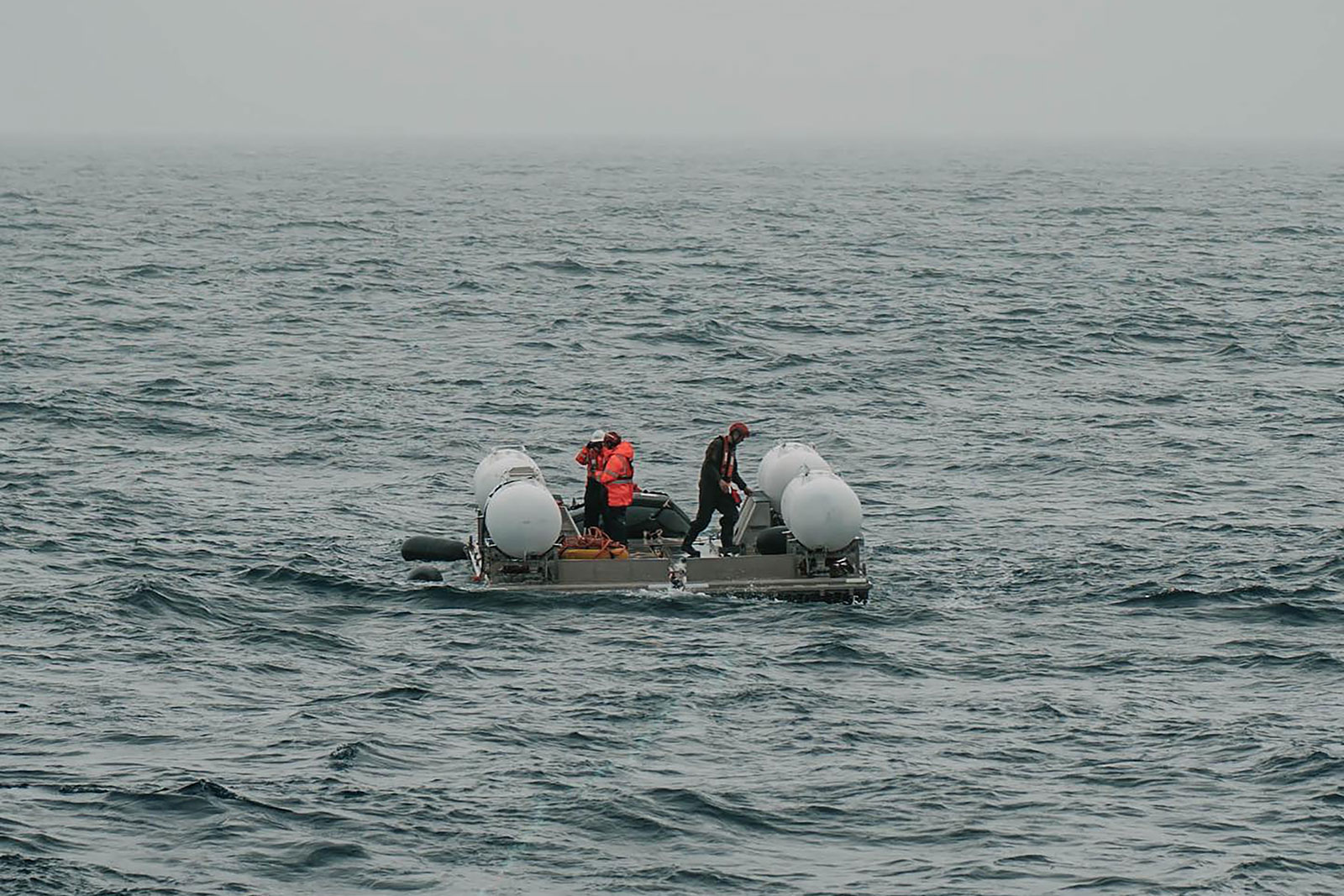
Another post from the account, posted on Saturday, noted that the weather had been bad but a "window" had opened up for Sunday.
Ocean Gate Expeditions, the company running the expedition, has not responded to CNN's inquiries about what happened during the dive.
CN is not naming the individual at this time but has reached out to their company for comment.
Expedition participant says team that launched missing sub is "focused on board here for our friends"
An expedition participant on board the Polar Prince, the ship that launched the now-missing submersible, said Monday that everybody is "focused on board here for our friends."
Rory Golden made the post on Facebook after being contacted by CNN.
"We have a situation that is now the part of a major Search and Rescue effort, being undertaken by major agencies," he wrote. "That is where our focus is right now."
He asked people not to ask for the names of the people on the missing submersible or speculate. “I have seen some comments already on social media that are highly inappropriate and insensitive,” he said.
Golden said that the online and internet options were being restricted "to keep bandwidth available for the coordinated effort that is taking place."
"The reaction and offers of help globally is truly astonishing, and only goes to show the real goodness in people at a time like this," he said.
Golden ended the post by thanking everyone and saying, "Think positive. We are.”
More agencies providing rescue coordination resources in search for missing vessel
From CNN's Raja Razek
The US Coast Guard's Maritime Rescue Coordination Center in Boston is coordinating the response to a report of a vessel bound for the Titanic wreckage that has gone missing, according to Fisheries and Oceans Canada.
The Canadian government department added that Joint Rescue Coordination Centre JRCC Halifax in Nova Scotia is also providing assistance.
CNN is reaching out to the Maritime Rescue Coordination Center in Boston.
US Coast Guard mobilizes aircraft in search for submersible near Titanic wreckage
From CNN's Kristina Sgueglia

The US Coast Guard is “bringing all assets to bear” in searching for a submersible near the Titanic wreckage that was reported “overdue” as of Sunday, an official said.
The particular submersible is “advertised to have 96 hours of survival time, I think that’s based on the amount of oxygen available in the capsule and so that gives us some time to continue searching and continue using all means to try and locate the crew members," District 1 Coast Guard Rear Admiral John Mauger told Fox News.
CNN reported earlier Monday that a search and was is underway for the missing submersible. It is operated by a company that handles expeditions to the Titanic wreckage off the coast of St John’s, Newfoundland in Canada, according to a company statement.
Assets including aircraft were immediately mobilized Sunday, Mauger said, adding the remote part of the ocean 900 miles off the Massachusetts coast is complicating the search and rescue.
US officials are coordinating with the Canadian Coast Guard and armed forces in the area who have also launched two of their own aircraft, he said. One particular piece of equipment has the ability to drop “sono buoys” and detect underwater noises.
“We don’t have equipment on site yet that can do a comprehensive sonar survey of the bottom, but we’re working very closely with our partners both within the federal government and in the Canadian armed forces and with private resources that are there to provide that capability,” he told Fox News.
“As you noted this is on the site of a wreckage, the wreckage Titanic, and so there’s a lot of debris on the bottom and locating an object on the bottom would be difficult but we will bring all assets to bare that we can to try and find the submersible and rescue the crew members," Mauger added.
He said if they were to find the vessel underwater, they would need to coordinate with the US Navy and Canadian armed forces to be able to pull it out.
Search and rescue underway for missing Titanic submersible

A search and rescue operation is underway for a missing submersible operated by a company that handles expeditions to the Titanic wreckage off the coast of St John’s, Newfoundland, in Canada.
“Our entire focus is on the crewmembers in the submersible and their families,” Ocean Gate Expeditions said in a statement Monday adding, they are “exploring and mobilizing all options to bring the crew back safely.”
“We are deeply thankful for the extensive assistance we have received from several government agencies and deep sea companies in our efforts to reestablish contact with the submersible,” according to a statement provided by CNN News Partner CTV.
“We are working toward the safe return of the crewmembers," it said.
CNN has reached out to the Boston Coastguard and authorities in Newfoundland, Canada.
Tanika Gray contributed reporting to this post.
Please enable JavaScript for a better experience.
Watch CBS News
What we know about the tourist sub that disappeared on an expedition to the Titanic
By Emily Mae Czachor
Updated on: June 23, 2023 / 11:35 PM EDT / CBS News
Five people on board the tourist submarine that disappeared on an expedition to explore the Titanic shipwreck over the weekend did not survive a "catastrophic loss of the pressure chamber," officials said Thursday.
The announcement came after the U.S. Coast Guard said the massive search underway in the North Atlantic had located a debris field on the sea floor, which was confirmed to be pieces of the missing sub .
"The debris field is consistent with a catastrophic implosion of the vessel," Rear Adm. John Mauger of the Coast Guard said at a briefing, offering "deepest condolences to the families." A spokesperson for OceanGate Expeditions, the company behind the voyage, told reporters that the passengers, including OceanGate CEO Stockton Rush, "have sadly been lost."
Here's what we know so far about the submersible craft and what led up to this point.
What happened?
A five-person crew on a submersible named Titan, owned by OceanGate Expeditions, submerged on a dive to the Titanic wreckage site Sunday morning, and the crew of the Polar Prince research ship lost contact with the sub about an hour and 45 minutes later, the Coast Guard said .
The Coast Guard first alerted mariners about the missing sub Sunday night, saying a "21 foot submarine" with a white hull was overdue and giving its last known position. "VESSELS IN VICINITY REQUESTED TO KEEP A SHARP LOOKOUT, ASSIST IF POSSIBLE," the alert message read.
The sub was lost in an area about 900 miles east of Cape Cod, in the North Atlantic, in water with a depth of about 13,000 feet, which is about level with the depth of the Titanic wreck . Amid growing concern about its dwindling supply of breathable air , search and rescue efforts by a unified command composed of several international agencies ramped up accordingly.
The five people aboard included an operator — later identified as Stockton Rush, the CEO of OceanGate Expeditions — and four mission specialists, a term the company uses for its passengers, who paid up to $250,000 for a seat.
For days, the fate of the sub and its passengers was a mystery.
But after the debris was found, a U.S. Navy official said the Navy had detected "an acoustic anomaly consistent with an implosion" shortly after the sub lost contact with the surface Sunday, CBS News national security correspondent David Martin reported. The information was relayed to the Coast Guard, which used it to narrow the radius of the search area, the official said.
Such an implosion, under the intense pressure of the depths of the sea , would have destroyed the vessel almost instantly, experts explained.
"in a fraction of a second, it's gone," Will Kohnen, chairman of the professional group the Marine Technology Society Submarine Committee, told the Reuters news agency.
"It implodes inwards in a matter of a thousandth of a second," Kohnen said. "And it's probably a mercy, because that was probably a kinder end than the unbelievably difficult situation of being four days in a cold, dark and confined space. So, this would have happened very quickly. I don't think anybody even had the time to realize what happened."
The Coast Guard is leading the investigation into the incident, and the National Transportation Safety Board said Friday it will assist.
Who were the passengers aboard the sub?
CBS News confirmed that the five people aboard the submersible were Hamish Harding , a 59-year-old British billionaire, business owner and explorer; British-Pakistani businessman Shahzada Dawood and his son, Suleman; French explorer Paul-Henri Nargeolet, who had made multiple dives over the years to explore the Titanic; and Stockton Rush, the CEO of OceanGate Expeditions, who was serving as pilot.
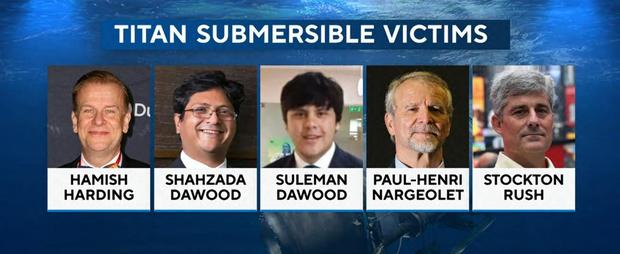
Just ahead of the Coast Guard briefing Thursday afternoon, a statement issued by OceanGate spokesperson Andrew Von Kerens offered condolences to the families of the Titan crew and recognized that all five people on board the submersible were believed to be dead.
"These men were true explorers who shared a distinct spirit of adventure, and a deep passion for exploring and protecting the world's oceans," the company said in the statement. "Our hearts are with these five souls and every member of their families during this tragic time. We grieve the loss of life and joy they brought to everyone they knew."
When the Coast Guard confirmed the sub's likely implosion on Thursday, Mauger said they were communicating with consulates general in both the U.K. and France.
The Dawood family, of the large Pakistan-based global business conglomerate Dawood Group, issued a statement Tuesday confirming their family members were on the expedition.
"Please continue to keep the departed souls and our family in your prayers during this difficult time of mourning," the Hussain and Kulsum Dawood family said Thursday in a statement through the Dawood Foundation. "We are truly grateful to all those involved in the rescue operations. ... The immense love and support we receive continues to help us endure this unimaginable loss."
Nargeolet, a renowned French explorer and former diver for the French Navy who was part of the first expedition to visit the Titanic wreck in 1987, was returning for another dive aboard the Titan submersible.
In a Facebook post on Monday, Rory Golden, an explorer who became the first Irish diver to visit the Titanic wreckage in 2000, said he was part of the voyage but was not on the submersible that went missing.
Search and rescue efforts
Authorities said early Thursday morning that a Canadian vessel, Horizon Arctic, had deployed a remotely operated underwater vehicle that reached the sea floor . The ROV ultimately located what the Coast Guard originally described as a debris field on the sea floor, which included identifiable pieces of the sub, authorities confirmed that afternoon.
"This morning, an ROV, or remote operated vehicle, from the vessel Horizon Arctic, discovered the tail cone of the Titan submersible approximately 1,600 feet from the bow of the Titanic on the sea floor," said Mauger at a news briefing. "The ROV subsequently found additional debris. In consultation with experts from within the unified command, the debris is consistent with the catastrophic loss of the pressure chamber."
"Upon this determination, we immediately notified the families," he added. "On behalf of the United States Coast Guard and the entire unified command, I offer my deepest condolences to the families. I can only imagine what this has been like for them and I hope that this discovery provides some solace during this difficult time."
Mauger said authorities were "still working to develop the details for the timeline involved with this casualty and the response," and referenced the "incredibly complex operating environment along the sea floor, over two miles beneath the surface."
Paul Hankins, an undersea expert for the U.S. Navy, explained during the news conference that crews discovered "five different major pieces of debris that told us that it was the remains of the Titan." These pieces included, initially, the nose cone, which was outside of the pressure hull.
"We then found a large debris field," Hankins said. "Within that large debris field, we found the front end bell of the pressure hull. That was our first indication that there was a catastrophic event."
A second, smaller debris field was located shortly after, and the debris found there "comprised the totality of that pressure vessel," Hankins said.
"The debris field is consistent with a catastrophic implosion of the vessel," he said, adding that the team will continue to map the debris field area.
Asked by a reporter what the prospects were for recovering the passengers, Mauger said, "This is an incredibly unforgiving environment down there on the sea floor, and the debris is consistent with a catastrophic implosion of the vessel. So we'll continue to work and continue to search the area down there, but I don't have an answer for prospects at this time."
Discovering the Titan debris came after multiple agencies from the U.S. and Canada spent days scouring thousands of square miles of open ocean in search of the missing sub.
The U.S. Coast Guard announced Wednesday that underwater noises were detected in the search area and that searches involving ROVs were focusing on the area where the noises were heard .
On Wednesday, three more vessels had arrived to join the search, including one with side-scan sonar capabilities designed to create images of large sections of the sea floor, the Coast Guard said in a tweet . That vessel began conducting search patterns alongside at least two others, as multiple military and other agencies worked together under a unified command.
Frederick said Wednesday there were five "surface assets" involved in the search , and another five were expected to join the operation within the next 24 to 48 hours. He said the team also had two ROVs "actively searching," with several more due to arrive to join the search Thursday.
The Coast Guard said it had C-130 aircraft searching for the sub, and that the Rescue Coordination Center Halifax was assisting with a P-8 Poseidon aircraft, which has underwater detection capabilities. Canadian P-3s were also involved in the operation and deployed sonar buoys.
Just after midnight Wednesday, officials said aircraft had detected underwater noises in the search area, and underwater search operations were relocated as a result, though the origin of the noises remained unknown. The sounds were picked up several times Tuesday night and Wednesday morning, according to the Coast Guard.
"With respect to the noises, specifically, we don't know what they are, to be frank with you," Frederick said. "The P-3 detected noises, that's why they're up there, that's why they're doing what they're doing, that's why there are sonar buoys in the water."
News of the vanished submersible and subsequent rescue mission originally broke Monday morning. At the time, Lt. Jordan Hart of the Coast Guard in Boston told CBS News that personnel there were leading the rescue mission, and focusing on waters off Newfoundland in eastern Canada.
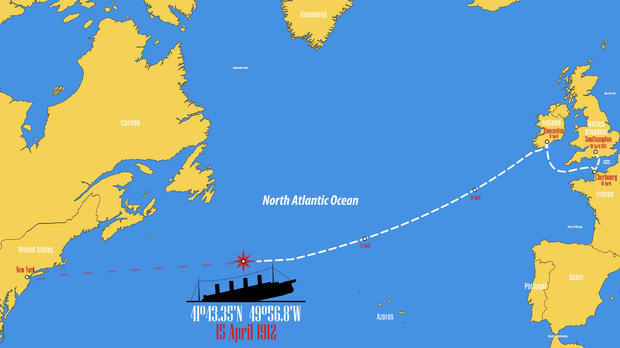
The Boston Regional Coordination Center was managing the rescue operation, as the location of the Titanic shipwreck falls within the Boston coordination center's territory, according to a map of jurisdictions along the East Coast of North America.
That combined search area grew to about twice the size of the state of Connecticut, and the subsurface search extended down as far as 2 and a half miles deep, Frederick said, stressing that the search and rescue teams were dealing with an incredibly complex set of circumstances.
"We also have to factor in the ever-changing weather conditions, currents and sea states that expand the search area every hour," he said earlier in the week. "There's an enormous complexity associated with this case due to the location being so far offshore and the coordination between multiple agencies and nations. We greatly appreciate the outpouring of support and offers to provide additional equipment."
What caused the noises?
Frederick acknowledged that the sounds detected underwater by Canadian aircraft could have been caused by multiple sources.
Following the discovery of the sub debris on the sea floor, a U.S. Navy source told CBS News that the implosion would be inconsistent with banging noises heard at 30-minute intervals. Those noises, the official said, are now assessed as having come from other ships in the area.
Carl Hartsfield, an expert in underwater acoustics and the director of the Woods Hole Oceanographic Institution, which is on-site at the search area as a consultant, explained that it can be challenging to differentiate between "human sounds" and "nature sounds" coming from beneath the surface.
"The ocean is a very complex place, obviously, human sounds, nature sounds, and it's very difficult to discern what the sources of those noises are at times," Hartsfield said.
Before the sub was found, Chris Roman, an associate professor of oceanography at the University of Rhode Island, told CBS News that, technically, it was possible that sounds from inside a submersible could have been detected, but that wasn't the only potential source of the noise.
"Sound travels very efficiently underwater. If people were intentionally making noises within the sub, it's very likely they could be detected with a sound buoy, and that position can be translated into a new search area," Roman said. But he also noted that, as Frederick mentioned in his briefing, "there's a lot of other things in the ocean that make noises."
The submarine
The unique submersible craft that disappeared was owned by OceanGate Expeditions , a company that deploys manned submarines for deep sea exploration and has in the past advertised this particular sub's voyages to carry tourists down to the wreckage of the RMS Titanic for $250,000 per seat.

More than a century after the Titanic sank in April 1912, the wreck lies on the ocean floor about 400 miles southeast of the Newfoundland coast.
OceanGate said recently on its website and on social media that its expedition to the shipwreck was "underway," describing the seven-night trip as a "chance to step outside of everyday life and discover something truly extraordinary." In addition to one ongoing expedition, the company had planned two others for the summer of next year, according to the site.
Because of the sub's oxygen capacity, it can only be fully submerged for a portion of the weeklong voyage. The sub has emergency oxygen and a 96-hour sustainment capability if there's an emergency aboard, Mauger said.
In a statement Monday after news broke of the missing sub, OceanGate confirmed the missing submersible was theirs and that a rescue operation had been launched to find and recover it. The company said it was "exploring and mobilizing all options to bring the crew back safely."
"For some time, we have been unable to establish communications with one of our submersible exploration vehicles which is currently visiting the wreck site of the Titanic," said Andrew Von Kerens, a spokesperson for OceanGate. "We pray for the safe return of the crew and passengers, and we will provide updates as they are available."
Inside the Titan
Dubbed the Titan, OceanGate's deep sea vessel, was said to be the only five-person submersible in the world with the capabilities to reach the Titanic's depth, nearly 2 and a half miles beneath the ocean's surface, CBS "Sunday Mornings" correspondent David Pogue reported last year.
BBC News reported that the vessel typically carries a pilot, three paying guests and another person described as a "content expert" by the company. OceanGate's site says the Titan, weighing around 23,000 pounds, has the ability to reach depths of up to 4,000 meters — over 13,000 feet — and has about 96 hours of life support for a crew of five people.
Last summer, Pogue accompanied the Titan crew on the journey from Newfoundland to the site where the Titanic as lost. Several dive attempts had to be canceled when weather conditions indicated it may not be safe. At the time, he described the Titan as a one-of-a-kind submersible craft made from thick carbon fiber and coated on both ends by a dome of titanium.
In 2018, a former employee of OceanGate Expeditions, submersible pilot David Lochridge, voiced concerns about the safety of the Titanic tour sub and filed a lawsuit against the company .
Lochridge, who was fired by OceanGate and sued by the company for allegedly disclosing confidential information in a whistleblower complaint to the Occupational Safety and Health Administration, said in a court filing that the Titan would carry passengers as deep as 4,000 meters even though that depth had never been reached in a sub with its type of carbon fiber hull. According to his claim, he learned the vessel was built to withstand a certified pressure of 1,300 meters, although OceanGate planned to take passengers to 4,000 meters.
Lochridge was not the only skeptic. The same year his complaint was filed, other industry leaders approached OceanGate with questions about the safety of its submersible. William Kohnen, president and CEO of Hydrospace Group, outlined his concerns in a 2018 letter to OceanGate, originally published by The New York Times, that warned of potentially "catastrophic" issues with the "experimental" sub, which was not certified. Kohnen told CBS News on Wednesday that although he did not send it, the letter was leaked to OceanGate and prompted the company to "amend a number of details that made sure the public knew" the submersible had not received its certification.
"The letter to Oceangate was meant as a professional courtesy to the CEO expressing industry concerns that the company was not following a traditional classification route for the certification of the submersible," Kohnen said. "The industry operates along an established and dynamic set of safety regulations and protocols that have served the submersible industry worldwide."
Ahead of his planned dive last summer, Pogue recalled signing paperwork that read, in part, "This experimental vessel has not been approved or certified by any regulatory body, and could result in physical injury, emotional trauma, or death."
Space inside the submarine was similar to the interior of a minivan, and, with just one button and a video game controller used to steer it, the vessel "seemed improvised, with off-the-shelf components," Pogue said.
On his voyage, the sub was lost for a few hours , Pogue said.
"There's no GPS underwater, so the surface ship is supposed to guide the sub to the shipwreck by sending text messages," he reported at the time. "But on this dive, communications somehow broke down."
You may remember that the @OceanGateExped sub to the #Titanic got lost for a few hours LAST summer, too, when I was aboard…Here’s the relevant part of that story. https://t.co/7FhcMs0oeH pic.twitter.com/ClaNg5nzj8 — David Pogue (@Pogue) June 19, 2023
Were conditions right for the dive?
G. Michael Harris, founder of RMS Titanic, Inc. — a company that salvages artifacts from the Titanic wreckage — told CBS News on Tuesday evening that Titanic expeditions are generally conducted within a "three-month weather window" between the end of June and September, when the ocean waters are at their calmest.
Harris, who has led several expeditions to the wreckage site, questioned why the Titan's dive was conducted as early as Sunday.
"Right now, it's really early in the season. I'm not sure why OceanGate went out this soon," Harris said.
Harris also noted that when he conducts diving expeditions, he uses a transponder system, something that he believed the Titan likely did not have.
"It's a net that we navigate in so that we know where we are at all times on the wreck of the Titanic," Harris said. "We're in constant communication with the vessel up top."
Harris said the Titan was "put on a sled and dumped in the water and their only navigation is from the support ship up top."
"I don't adhere to that myself, personally," Harris said.
Harris noted that he has worked with Nargeolet, who is listed as director of underwater research for RMS Titanic, for the past 30 years, describing him as an "all-around good guy."
Who was Hamish Harding?
Harding, the first of the passengers to be publicly identified, had previously posted on social media about joining the Titanic shipwreck expedition.
In a post shared to his Facebook page on Saturday, Harding wrote: "I am proud to finally announce that I joined OceanGate Expeditions for their RMS TITANIC Mission as a mission specialist on the sub going down to the Titanic."
I am proud to finally announce that I joined OceanGate Expeditions for their RMS TITANIC Mission as a mission specialist... Posted by Hamish Harding on Saturday, June 17, 2023
"Due to the worst winter in Newfoundland in 40 years, this mission is likely to be the first and only manned mission to the Titanic in 2023," Harding's Facebook post continued. "A weather window has just opened up and we are going to attempt a dive tomorrow. We started steaming from St. Johns, Newfoundland, Canada yesterday and are planning to start dive operations around 4am tomorrow morning. Until then we have a lot of preparations and briefings to do."
That post was Harding's most recent social media update related to the submarine trip. It included multiple photographs of him, including one that showed Harding signing his name on a banner that read "Titanic Expedition Mission V" and another that pictured the submersible vessel itself.
Richard Garriott de Cayeux, president of The Explorers Club, where Harding helped found the board of trustees, said they had spoken just a week earlier about the expedition.
"When I saw Hamish last week at the Global Exploration Summit, his excitement about this expedition was palpable. I know he was looking forward to conducting research at the site," he said in a letter to club members after the sub's disappearance.
Harding was a veteran adventure tourist who also traveled to space aboard a Blue Origin rocket last year. Two years ago, he made it to the deepest part of the ocean, traveling with U.S. explorer Victor Vescovo to the floor of the Mariana Trench, 35,876 feet below the sea surface. That trip, in a $48 million submersible, earned both explorers the Guinness World Record for the longest distance traveled at the deepest part of the ocean by a crewed vessel.
"It was potentially scary, but I was so busy doing so many things — navigating and triangulating my position — that I did not really have time to be scared," Harding told The Week after that excursion.
This is an updated version of an article originally published on Monday, June 19. Reporting contributed by Emmet Lyons, Roxana Saberi, Alex Sundby, Aimee Picchi, Aliza Chasan, Li Cohen, Caroline Hinson, Anna Noryskiewicz, Analisa Novak and other CBS News staff.
- Newfoundland
- United States Coast Guard
Emily Mae Czachor is a reporter and news editor at CBSNews.com. She covers breaking news, often focusing on crime and extreme weather. Emily Mae has previously written for outlets including the Los Angeles Times, BuzzFeed and Newsweek.
More from CBS News
- Skip to main content
- Keyboard shortcuts for audio player
Here's the latest on the missing Titan submersible and the race to rescue passengers
Emily Olson
Ayana Archie

U.S. Coast Guard Capt. Jamie Frederick speaks during a press conference about the search efforts for the submersible that went missing near the wreck of the Titanic in Boston on Tuesday. Joseph Prezioso/AFP via Getty Images hide caption
U.S. Coast Guard Capt. Jamie Frederick speaks during a press conference about the search efforts for the submersible that went missing near the wreck of the Titanic in Boston on Tuesday.
For the latest updates on the search for the missing submersible, head here.
As of Tuesday night, five passengers aboard a submersible in the North Atlantic are the subject of an international search. The vessel is owned by OceanGate, and designed to explore the site of the Titanic.
Authorities estimate there's only enough oxygen in the submersible to last for less than two days.
Here's what we know:
When and where did the vessel go missing?

Missing submersible: Rescuers race to find Titan after detecting underwater noises
The 21-foot vessel, which is named Titan , lost communication with its control center on Sunday morning, roughly 1 hour and 45 minutes into its scheduled dive, the U.S. Coast Guard wrote on Twitter.
Titan had been deployed by a Canadian expedition ship, the Polar Prince, about 435 miles (380 nautical miles) south of St. John's in Newfoundland, not far from the site of the iconic shipwreck.
Why was the submersible diving?
The missing vessel is owned by OceanGate, a company based in Washington state that offers underwater voyages to explore the remains of the Titanic from the seafloor.

'Tiny sub, big ocean': Why the Titanic submersible search is so challenging
OceanGate is a major chronicler of the ship's decay and shared the first-ever full-size digital scan of the wreck site in May.
OceanGate is also a pioneer in the deep sea tourism economy. For $250,000 a person, the company takes adventurers on a deep sea tour lasting eight days and stretching hundreds of miles.
From St. John's in Newfoundland, Canada, explorers travel 380 miles offshore and 2.4 miles below the surface.

A remarkable new view of the Titanic shipwreck is here, thanks to deep-sea mappers
If successful, they can catch a glimpse of what's left of the 1912 iceberg-crash disaster, which took the lives of all but 700 of the Titanic's 2,200 passengers and crew. Today, the ship is slowly succumbing to a metal-eating bacteria , which may cause it to fully disintegrate in a matter of decades.
Mike Reiss , who joined OceanGate to glimpse the deteriorating wreck in 2022, said the trip is less tourism than it is true exploration — and the people who dare to try it are made well aware of the risks.
"You sign a massive waiver that lists one way after another that you could die on the trip," he told the BBC in an interview Tuesday. "They mention death three times on page one. So it's never far from your mind. As I was getting on to the sub, that was my thought: That this could be the end."
'You sign a massive waiver that you could die on the trip' As search teams race against time to find the small sub that went missing during a dive to the wreck of the Titanic, writer Mike Reiss told #BBCBreakfast about taking the same trip last year https://t.co/FNeiSyZfLl pic.twitter.com/2STvm7YDbz — BBC Breakfast (@BBCBreakfast) June 20, 2023
Who was on board?
The Titanic-touring vessel contained one pilot and four paid passengers called "mission specialists," according to the U.S. Coast Guard. "Mission specialists" take turns operating sonar equipment and performing the tasks necessary to complete a dive.
Among those paid passengers was British businessman Hamish Harding, according to a statement from Action Aviation , a company where Harding works as chairman.
Harding holds three Guinness World Records, including the longest duration (4 hours, 15 minutes) at a full ocean depth (2.88 miles) by a crewed vessel. He has also trekked to the South Pole, circumnavigated the Earth in less than 48 hours and visited space in Blue Origin's New Shepard rocket .

Newly released footage of a 1986 Titanic dive reveals the ship's haunting interior
Shahzada Dawood and his son Suleman, two members of a prominent Pakistani family known for investing, were also on board the vessel, according to a statement shared with outlets such as The Associated Press .
A fourth person on board is Paul-Henri Nargeolet, a French expert on the Titanic, his agent has confirmed to several outlets, including The New York Times . Nargeolet serves as director for RMS Titanic Inc. , the U.S. company that owns the salvage rights to the Titanic site. The Times reports that Nargeolet has completed over 35 dives to the wreckage, including a previous Titan expedition.
Titan's pilot and the fifth person has been identified as OceanGate CEO Stockton Rush.
Why did the vessel go missing?

This 2004 photo shows the remains of a coat and boots in the mud on the sea bed near the Titanic's stern. Institute for Exploration, Center for Archaeological Oceanography/AP hide caption
This 2004 photo shows the remains of a coat and boots in the mud on the sea bed near the Titanic's stern.
It's still unclear why the submersible lost communication with its control crew on the expedition ship.
Ahead of its launch, OceanGate said it would rely on the satellite-based internet company Starlink for the communications necessary for carrying out the expedition. A text-message-based system relying on underwater acoustic positioning normally allows the Titan to communicate with the control ship, according to an Australian researcher writing for The Conversation.
OceanGate says its vessels are "equipped with some basic emergency medical supplies and 96 hours of life support," according to the company's website .

Pop Culture Happy Hour
'titanic' was king of the world 25 years ago for a good reason.
And for good reason: This is not the first time an OceanGate submersible has gotten lost, according to David Pogue, a correspondent for CBS Sunday Morning .
Pogue, who traveled on an OceanGate expedition to see the Titanic last summer, recalled that the control room was unable to help the submersible locate the wrecked liner for roughly three hours due to technical difficulties.

James Cameron aims to finally put that 'Titanic' door debate to rest, 25 years later
"The difference this year is that it seems like they lost contact with the ship," Pogue told NPR. "They can't even reach the sub and that's really scary."
He added that factors like bad weather and mechanical issues mean the submersible vessels rarely make it to the Titanic, despite the expensive price tag. This season has seen zero successful dives, Pogue said.
What's it like inside the Titan?
Videos from Pogue's initial CBS Sunday Morning report on OceanGate show him reading from the "mission specialist" waiver, which points out that Titan has not been approved or certified "by any regulatory body."
"I couldn't help noticing how many pieces of this sub seem improvised," Pogue adds.
“Hope is quickly fading” to find the missing submersible that left for a mission to the wreckage of the Titanic, says @Pogue , who went on board the same sub last year. He says it could be impossible to rescue the passengers if the sub is still underwater. pic.twitter.com/n0NTsLYkIJ — CBS Mornings (@CBSMornings) June 20, 2023
A single plastic bottle and some Ziploc bags stand in for a toilet. An Xbox game controller and an elevator-esque up/down button serve as the vessel's primary controls. The interior lighting is from Camping World, notes OceanGate founder Stockton Rush.
In whole, the space inside is about the size of a minivan, not tall enough for someone to fully stand.
In an interview with NPR's All Things Considered , Pogue said there are seven different ballast mechanisms that can help the Titan rise from great depths.
"Some of these work even if the power is out or even if everyone on board is passed out," Pogue said.
The fact that rescue crews haven't spotted the vessel on the ocean's surface might mean that the Titan is snagged or its 5-inch-thick carbon fiber hull was penetrated, Pogue said.
Either situation could be catastrophic for the people on board.
What's the latest on the search efforts?
As of Tuesday at 1 p.m. ET, the Titan had about 40 hours of oxygen left, said Capt. Jamie Frederick, a response coordinator for the U.S. Coast Guard overseeing the search.
A unified command including the U.S. Coast Guard, the U.S. Navy, the Canadian Coast Guard and OceanGate are working together to steer the search efforts, but so far, has come up unsuccessful, Frederick said during a press conference.

TED Radio Hour
Robert ballard: what hidden underwater worlds are left to discover.
"We wouldn't be searching and putting all effort out there" if the submersible wasn't recoverable, Frederick said, adding that the crews contain the "nation's best experts."
Several Canadian Coast Guard vessels were en route to the scene, as were several additional private vessels.
The teams in place are continuing to use aircraft to scan the ocean, an effort that may get easier on Tuesday as Monday's heavy fog was lifting, said a Coast Guard spokesperson.
Sonar devices are also being employed to detect possible underwater sounds coming from the submersible. Crews have covered 7,600 square miles — an area bigger than the state of Connecticut.

How (and why) this man plans to live underwater for 100 days
The teams also expanded their underwater search capability on Tuesday by adding a remotely operated vehicle in order to reach lower depths. That search is ongoing.
But even if the crews can locate the vessel at a low depth, hauling it up to the surface is another task. The Titan could be at a depth of over 13,000 feet and a distance of over 900 miles offshore. Frederick said the search and rescue crews did not yet have salvage equipment in place.
David Marquet, a retired U.S. Navy submarine captain, told NPR's Morning Edition that the odds of survival are "about 1%."
A former OceanGate executive voiced safety concerns years ago
A fired OceanGate employee urged for additional testing on the hull of the Titan years earlier, according to a 2018 lawsuit. Former director of marine operations David Lochridge sent a report he authored in January 2018, which voiced concerns that the hull used carbon fiber and not a metallic composition. The Titan was being designed to travel 4,000 meters below the surface, which had never been done by an OceanGate vessel with a hull made of carbon fiber, Lochridge stated in court documents.
Furthermore, Lochridge said vessel's viewport, which allows passengers to look outside, was only certified by the manufacturer to withstand pressures at 1,300 meters below the surface. That was due to OceanGate's design of the vessel, which did not meet federal standards, according to the complaint.
Lochridge said he encouraged a nondestructive scan of the hull to check for any defects, rather than solely relying on acoustic monitoring. According to Lochridge, acoustic monitoring only detects a problem in the hull right before it fails.
Lochridge said his concerns were ignored and he was told equipment did not exist for the type of test he was asking for. "The paying passengers would not be aware, and would not be informed, of this experimental design, the lack of non-destructive testing of the hull, or that hazardous flammable materials were being used within the submersible," court documents state. Lochridge was fired in January 2018. In its lawsuit against Lochridge, OceanGate said they did not hire him to do engineering work. However, Lochridge says he made the report at the request of CEO Stockton Rush because the plans for the Titan were being passed from the engineering team to his operations department. Lochridge, who has experience as a submersible pilot and diver, was hired by OceanGate in May 2015 as an independent contractor and later became an employee, according to documents. OceanGate sued Lochridge for fraud, breach of contract, misappropriation of trade secrets and nearly $24,000, claiming that he repeatedly violated the nondisclosure agreement he signed by talking to at least two people about plans for the Titan.
The agreement stated he would not disparage the company and would "hold [OceanGate's] confidential information in strict confidence, and not disclose or use it except as authorized by [OceanGate] and for [OceanGate's] benefit." Lochridge denied violating the NDA, saying it was not properly executed and that his report was not critical of the company. He countersued for wrongful termination, though the parties ultimately reached a settlement.
NPR's Juliana Kim and Tovia Smith contributed reporting.
Correction June 20, 2023
A previous version of this story stated that the submersible has a 5-foot-thick carbon fiber hull. In fact, the hull is 5 inches thick.
- deep sea exploration
Search underway for Titanic tourist submarine with 70-96 hours of oxygen left: Live updates
Editor's note: This page reflects the search for the submersible as of Monday evening. For the latest updates on the race against time to locate and rescue the submersible, please follow our live updates for Tuesday, June 20 .
U.S. and Canadian rescue teams were searching Monday for a submersible carrying five people to the wreckage site of the Titanic after the submarine vanished deep in the Atlantic Ocean with four days' or less worth of survival capability .
The U.S. Coast Guard in Boston is leading the search for the missing watercraft, which the Joint Rescue Coordination Centre in Halifax, Nova Scotia, said was reported overdue Sunday night about 435 miles south of St. John’s, Newfoundland.
Rear Adm. John Mauger, commander of the First Coast Guard District, said two aircraft each from the U.S. and Canada were involved in the search, along with a commercial ship, and that further assets will be added as the pursuit continues into the night.
The operation's location − about 900 miles east of Cape Cod and up to 13,000 feet deep − complicates the task, as does the need to look both on the surface of the water and below, he said.
"It is a challenge to conduct a search in that remote area,'' Mauger said at a news conference, "but we are deploying all available assets to make sure that we can locate the craft and rescue the people on board.''
Contact lost with five crew members
The Coast Guard tweeted that the 21-foot submersible named "Titan,'' which left from St. John's, began its dive Sunday morning. The Polar Prince, the Canadian ship supporting the watercraft, lost contact with it about an hour and 45 minutes later.
OceanGate Expeditions , a Washington-based deep-sea exploration company, confirmed in a statement that it owned the submersible − a vessel in the submarine family but smaller and less self-sufficient than the classic military sub.
The company's expeditions to the Titanic wreck site include archaeologists and marine biologists. OceanGate also brings people who pay to come along, known as “mission specialists.”
They take turns operating sonar equipment and performing other tasks in the five-person submersible. The Coast Guard said Monday there was one pilot and four “mission specialists” aboard.
“We are deeply thankful for the extensive assistance we have received from several government agencies and deep sea companies in our efforts to reestablish contact with the submersible,” OceanGate said. “We are working toward the safe return of the crewmembers.”
Based on the company's information, Mauger said the submersible has a 96-hour emergency sustainment capability, which would include oxygen and fuel. "So we anticipate that there's somewhere between 70 and the full 96 hours available at this point,'' he said.
See the Titanic in whole new way: Full-sized, 3D digital scan shows scale of wreckage site
British tourist on board
OceanGate adviser David Concannon told The Associated Press the company lost contact with the submersible Sunday morning.
Concannon, who said he planned to go on the dive but had to cancel because of a matter regarding another client, said officials are rushing to get to the site a remotely operated vehicle that can reach a depth of 20,000 feet. The Titanic wreckage is believed to lie 12,500 feet deep.
Action Aviation said its company chairman, British businessman Hamish Harding, was one of the travelers on board . The experienced adventurer went into space on Blue Origin’s New Shepard rocket last June.
“Every attempt is being made for a rescue mission,'' Mark Butler, the company’s managing director, told the AP. "There is still plenty of time to facilitate a rescue mission. There is equipment on board for survival in this event. We’re all hoping and praying he comes back safe and sound.”
Richard Garriott, president of the Explorers Club − a New York-based group that supports scientific exploration − said he saw Harding a week ago and “his excitement was palpable.''
“I know he was looking forward to conducting research at the site,” Garriott wrote in a letter to members. “We all join in the fervent hope that the submersible is located as quickly as possible and the crew is safe.”
Search to continue overnight
The Coast Guard said late Monday that two searches by C-130 aircraft had been completed and the mission would continue though the night.
"The Polar Prince and @Rescue106 will continue to do surface searches throughout the evening," the First Coast Guard District tweeted .
The Guard said Canadian and US aircraft will resume looking underwater and on the ocean's surface Tuesday.
Titanic facts: When did it sink? How many people died?
On April 14, 1912, the Titanic collided with an iceberg in the North Atlantic on its maiden voyage from Southampton, England, to New York City. On April 15, at about 2:20 a.m., the ship sank.
More than 1,500 people died on the Titanic. Of the roughly 2,200 people aboard the ship, only 706 survived.
The majority of the people killed were members of the crew and third-class passengers. There were 710 deaths in the third class and 700 deaths among the crew.
How many people died on the Titanic?: Facts about the death toll and the survivors
Tourists added for expeditions
In 2021, OceanGate Expeditions began what it expected to become an annual voyage to the wreckage. The company had said it would include about 40 paying tourists to the team of archaeologists and marine biologists on the trips.
The initial group of tourists spent $100,000 to $150,000 apiece.
Contributing: The Associated Press
Newest luxury submersible offers ocean explorers champagne and blackjack
'...you feel at one with the water.'
By Mack DeGeurin | Published Apr 25, 2024 10:33 AM EDT
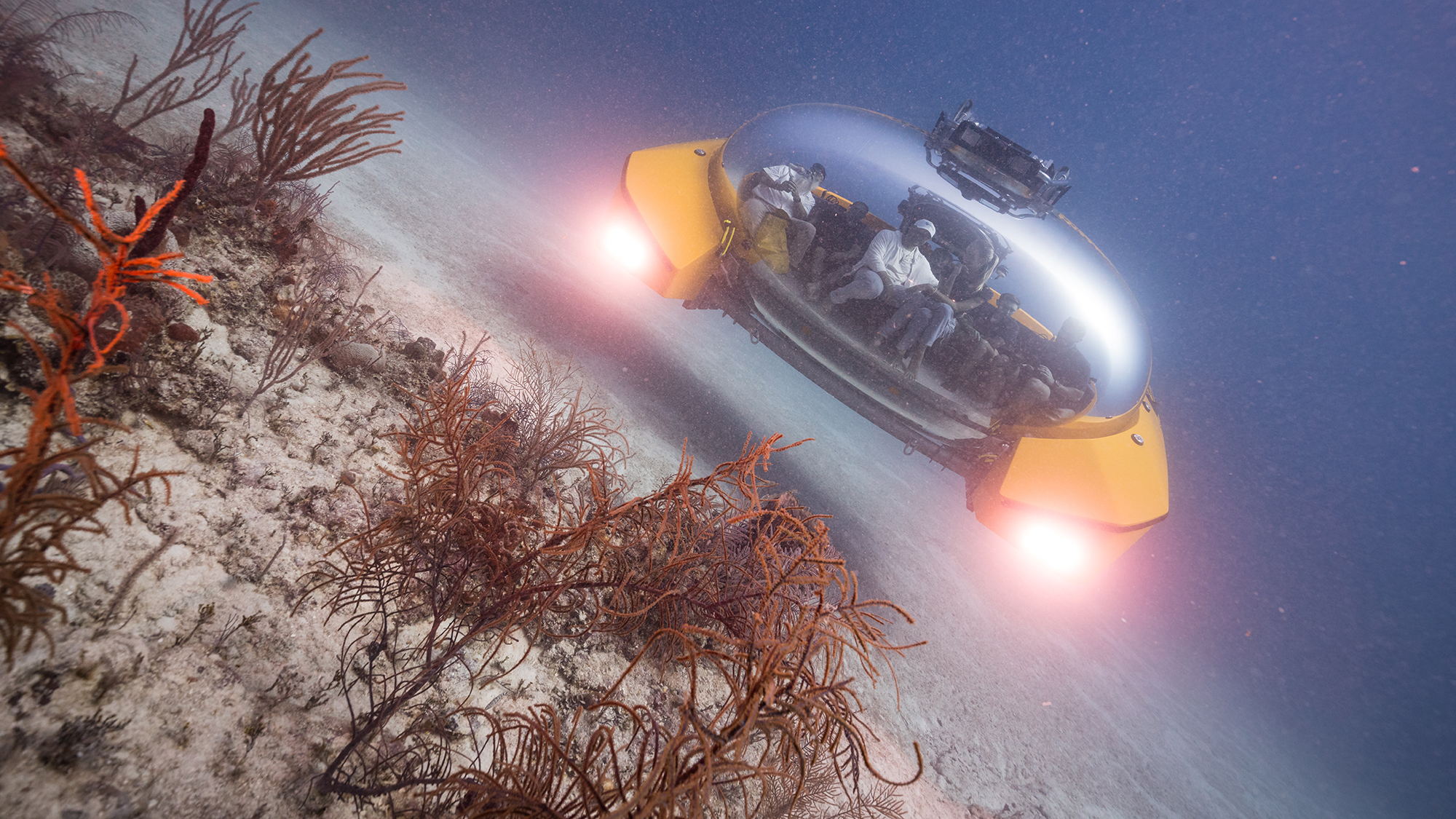
When OceanGate’s under-tested Titan submersible went missing last summer , it captured the attention of millions worldwide. Authorities frantically scoured the North Atlantic Ocean for days only to eventually determine the small vessel had catastrophically imploded , killing its five passengers instantly . The tragic incident doesn’t appear to have actually slowed demand or interest in the vessels among its audience of passionate, and often wealthy , underwater exploration enthusiasts. The latest in ocean submersibles by a different company, Triton, recently delivered its most eye-catching submersible to date dubbed the 660/9 AVA . This particular submersible won’t dive as deep as some industry competitors—or as deep as the Triton 36000/2 aka Limiting Factor which Triton says is “the deepest diving sub in the world.” However, the new 660/9 AVA does promise passengers an over-the-top, luxurious experience.
660/9 AVA can plunge 600 feet below the surface. (Deep-sea technically begins at 656 feet. ) The submersible will offer eight passengers and a pilot a panoramic view of the water world surrounding them. In a video released this week highlighting the submersible, Triton described the 660/9 AVA as “a vessel of discovery crafted for extraordinary experiences.” Triton delivered its first 660/9 AVA to a cruise company earlier this month.

The vessel’s elongated, bubble-like design is part of what Triton describes as the world’s first “free-form acrylic pressure hull.” Occupants who can afford a trip in the glitzy submersible can explore marine life in style. Triton says passengers can engage in a variety of premium activities including “cocktail dives,” “spa treatment,” and “subsea gaming.” A render of the submersible on Triton’s website shows it equipped with a blackjack table, dining arrangements, and plenty of champagne.
Triton derived its first 660/9 AVA to the firm Scenic Luxury Cruises & Tours earlier this month. That specific sub has been bestowed the name “Scenic Neptune II.” Over the next two years passengers will have the opportunity to lower the submersible down for a look though ocean waters off the coasts of New Zealand, Indonesia, and even East Antarctica.

“The clarity of the acrylic hull once submerged is such that you feel at one with the water,” Scenic Luxury Cruises & Tours Director of Discovery Operations Jason Flesher said in a statement. “Encountering the vibrant marine life of the South Pacific and Australia’s Great Barrier Reef within Scenic Neptune II will create memories to last a lifetime.”
Triton was founded in 2007. Since then, its fleet of various submersibles have been used for everything from deep-sea research and film making to ambitious ocean exploration. Some of the biggest celebrity names in submersible ocean exploration, like hedge fund manager Ray Dalio and acclaimed film director James Cameron, have previously partnered with the company . Both Dalio and Cameron have expressed interest in using vessels like these to discover new parts of the ocean still shrouded in darkness.
Updates 04/26/24: The spelling of “Triton” has been corrected in the final paragraph of this post . A mention of Triton’s other, deeper-diving sub has been added.
Like science, tech, and DIY projects?
Sign up to receive Popular Science's emails and get the highlights.

The Last Meal Of The Titanic's First-Class Passengers
T he wreck of the RMS Titanic endures as the most infamous maritime tragedy in history, claiming roughly 1,500 lives as it sank below the frigid waters of the North Atlantic. Countless books, articles, documentaries, and movies have relayed what happened on the night of April 14, 1912; but in our obsession over the Titanic passengers' deaths, we often overlook how they lived.
The Titanic was the subject of international fame long before it sank. Hailed as one of the largest and most luxurious ships ever built, its passengers included some of the wealthiest people in the world at the time, including John Jacob Astor IV, Benjamin Guggenheim, and Isadore Straus, the owner of Macy's. Captain Edward Smith was even known as the "Millionaire's Captain" because of his ties with the wealthy.
These fabulously rich passengers stayed in the Titanic's opulent first-class quarters, where a suite cost £870, which translates to a stunning $133,132 in today's dollars. Tickets included meals in the ship's first-class dining hall, where diners could enjoy as many as 13 courses for dinner, each one accompanied by a different wine pairing . A few menus from this dining room survived the wreck (later selling for a staggering amount of money) , so we know exactly what those first-class passengers ate for their last meal. It seems that the Titanic's dining room would have held its own against any of the world's finest restaurants.
Read more: How Restaurant Steak Tricks Your Tastebuds
The First-Class Menu Was The Epitome Of Luxury
A dinner menu from the night of April 14 reveals that the first-class passengers aboard the Titanic ate an extravagant dinner, beginning with assorted hors d'oeuvres and oysters. They then had a choice of soup between cream of barley and consommé Olga, a soup made from veal stock and sturgeon marrow. This was followed by salmon with mousseline sauce. It sounds like a well-rounded meal already, but the Titanic chefs were just getting started.
For entrees (that's right, the salmon was an appetizer course), guests could choose between filet mignon, chicken lyonnaise, lamb with mint sauce, roast duck, or beef sirloin with chateau potatoes. There was also a vegetarian option: vegetable marrow farci (marrow is a type of summer squash native to England). An array of side dishes were offered, including peas, carrots, and rice. After their entrees, guests were served a palate-cleansing punch followed by roast squab, asparagus, and foie gras . For dessert, there were peaches with jelly, vanilla and chocolate eclairs, French ice cream, and Waldorf pudding.
The first-class lunch that day was almost as opulent. The midday menu included mutton chops, roast beef, ham, ox tongue, custard pudding, a cheese course, and a rather intriguing chicken and banana dish . This was fine dining at its most indulgent.
What The Other Passengers Ate
The ship was divided into three classes to match the economic hierarchy: the upper, the middle, and the lower class. The Titanic was among the first ocean liners to include a second class, reflecting the newly-formed middle class that emerged at the tail end of the 19th century. Of the 1,317 passengers aboard that voyage, only 324 were in first class. The 284 second-class passengers and 709 third-class passengers ate very different meals.
The second-class dinner on April 14 wasn't as luxurious as the first-class fare, but it was still a gourmet meal. There was only one soup offering — consommé tapioca, and the entree choices included curried chicken, lamb with mint sauce, and roast turkey with cranberry sauce (sorry vegetarians, but there was no meat-free dinner option below first class). There were many options for dessert, including plum pudding and wine jelly, but the ice cream served to second-class passengers was explicitly American rather than French.
Third-class passengers had a very different experience. Their day was divided into four meals: breakfast, dinner, tea, and supper. Breakfast was hearty, with oatmeal, smoked herring, ham and eggs, and fresh bread. The dinner entree was roast beef with rice soup and boiled potatoes, while supper consisted of cheese, cabin biscuits, and gruel. It was hearty food, but it couldn't have seemed like much when the guests in first class were feasting on multiple meat courses for every meal.
Read the original article on Chowhound
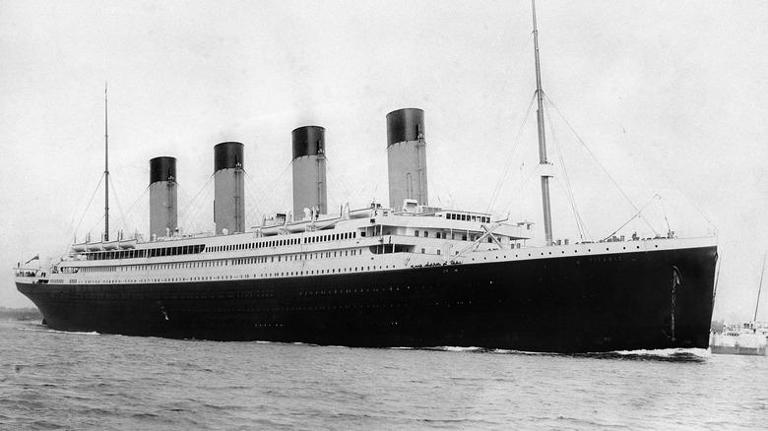
Gold watch worn by richest passenger aboard Titanic to be sold at auction
By emily blumenthal, cnn | posted - april 27, 2024 at 7:46 p.m., john jacob astor iv's pocket watch is expected to fetch between $125,000 and $188,000. (henry aldridge & son ltd).
Estimated read time: 2-3 minutes
NEW YORK — A gold watch worn by John Jacob Astor IV, a member of the wealthy Astor family and the richest man aboard the Titanic, will go up for sale at an auction of memorabilia from the doomed ship.
Astor was one of around 1,500 people who died when the Titanic sank on April 15, 1912, after hitting an iceberg. His pregnant wife, Madeleine, survived.
The watch is among a number of notable items on offer at auction house Henry Aldridge & Son in Wiltshire, England, on Saturday, including the valise that held the violin famously played by the band leader as the ship sank, and a pocketbook that documents the Titanic's scheduled voyages. The violin itself was sold for $1.7 million via the same auction house in 2013 and is the highest-selling item from the ship ever.
The watch is expected to sell for between $125,000 and $188,000 and the valise for between $125,000 and $150,000, according to Andrew Aldridge, the managing director of auction house Henry Aldridge & Son. Bidding began Saturday at 5 a.m. MT, Aldridge told CNN.
The watch was among the personal effects found with Astor's body after the Titanic sank, according to the auction house. He also had gold cufflinks, a diamond ring, money and a pocketbook on him, among other items.
After the recovery of Astor's body, those possessions were sent to his son, Vincent Astor, who completely restored the watch so that it worked. In 1935, Vincent gave the watch as a christening gift to the infant son of William Dobbyn IV, John Jacob Astor's executive secretary, according to the auction house.
Aldridge told CNN that the Dobbyn family kept the watch until the late 1990s, when it went to auction.
An unnamed collector in the United States bought the watch at this auction and is the current seller. Since then, it has been displayed in several museums.
"So, you know, over the course of its time, quite literally millions of people have viewed it, which is fabulous," Aldridge said.
John Jacob Astor IV's cufflinks and plan of the Titanic's first-class accommodation are also on offer at Saturday's auction. The cufflinks are expected to sell for between $6,250 and $10,000 and the accommodation plan for between $25,000 and $37,500.
Most recent Business stories
Walmart to close its 51 health centers, virtual care service, us home prices rose in february at the fastest pace in more than a year, is tesla's autopilot safe legal challenges abound, related topics, more stories you may be interested in.

Tractor-trailers with no one aboard? The future is near for self-driving trucks on US roads

Biden administration delays plan to ban menthol cigarettes
Most viewed.
- Man dies in St. George motorcycle accident
- 1 climber dead and 1 severely injured after 1,000-foot fall off mountain in national park
- Holladay family looking for new housing after neighboring home destroyed by ancient dynamite
- Idaho Falls man kicks Yellowstone bison and goes to jail, say park officials
- College protests over war in Gaza reach Utah; 17 arrested
- Man accused of shooting Vernal officer charged with attempted murder
- Dozens of officers respond to West Jordan home after fake call to 911
- Hill Aerospace Museum's $22M expansion complete, opens to public on Thursday
- 4 law officers serving warrant are killed, 4 wounded in shootout at North Carolina home
- Salt Lake City unveils renderings of a new traffic circle sculpture
STAY IN THE KNOW

KSL Weather Forecast


IMAGES
COMMENTS
01:55 - Source: CNN. CNN —. Authorities have said the Titanic-touring submersible that went missing on Sunday suffered a "catastrophic implosion," killing all five people on board while ...
The five people who were aboard a submersible that went missing while on an expedition to explore the wreckage of the Titanic did not survive, according to the company that arranged the trip. The ...
What we know about the 5 men who were aboard the wrecked Titan sub. The five men who were aboard the Titan were declared dead on Thursday after search and rescue crews found evidence the ...
AFP via Getty Images. After days of desperate searches throughout the Atlantic Ocean, the U.S. Coast Guard announced Thursday that the five passengers aboard the missing submersible vessel were ...
By Emma Bubola , Salman Masood and Victoria Kim. June 23, 2023. Five people were on board the Titan submersible when it lost contact with its support ship during a dive to the Titanic wreckage ...
The next year, a submersible expert heard cracking sounds during a Titan dive in the Bahamas and, in an email to Mr. Rush, begged him to suspend operations. Mr. Rush made some revisions but kept ...
0:00. 1:47. Five men, including one teenager, have been declared dead days after they left for a voyage in a 22-foot submersible to see the wreckage of the Titanic in the North Atlantic Ocean ...
OceanGate, the tour company, has said all 5 passengers are believed dead. The Titan: The voyage to see the Titanic wreckage is eight days long, costs $250,000 and is open to passengers age 17 and ...
Jesus Jimenez. The U.S. Coast Guard said in statement that it was searching for five people after the Canadian research vessel MV Polar Prince lost contact with a submersible during a dive about ...
June 22, 2023 Updated 5:17 PM PT. NEW YORK —. All five passengers aboard a submersible that vanished while on a dive to explore the Titanic wreck site have died, officials said Thursday after ...
Nargeolet led several expeditions to the Titanic wreckage site, completing at least 35 dives in submersibles and supervising the recovery of at least 5,000 artifacts, including the recovery of the ...
0:48. A submersible carrying a pilot and four commercial passengers including a British billionaire, a French explorer and two members of one of Pakistan's most prominent families, went missing ...
OceanGate has given a new update on the five passengers aboard the Titan, a Titanic -bound submersible, after it went missing on June 18. On June 22, the company shared a statement with PEOPLE ...
From CNN's Celina Tebor and Gabe Cohen. The missing submersible near the Titanic wreckage lost contact with a crew 1 hour and 45 minutes into its descent Sunday morning, according to the US ...
What to know about the 5 passengers on the missing Titanic sub 00:52 ... voiced concerns about the safety of the Titanic tour sub and filed a ... Space inside the submarine was similar to the ...
On 18 June 2023, Titan, a submersible operated by the American tourism and expeditions company OceanGate, imploded during an expedition to view the wreck of the Titanic in the North Atlantic Ocean off the coast of Newfoundland, Canada.Aboard the submersible were: Stockton Rush, the American chief executive officer of OceanGate; Paul-Henri Nargeolet, a French deep-sea explorer and Titanic ...
The Titan, a minivan-size submersible, was carrying five people to the Titanic's watery grave when it lost contact. The vessel has enough oxygen to keep its passengers alive for about 40 more hours.
On April 14, 1912, the Titanic collided with an iceberg in the North Atlantic on its maiden voyage from Southampton, England, to New York City. On April 15, at about 2:20 a.m., the ship sank. More ...
However, the new 660/9 AVA does promise passengers an over-the-top, luxurious experience. 660/9 AVA can plunge 600 feet below the surface. (Deep-sea technically begins at 656 feet.
The wreck of the RMS Titanic endures as the most infamous maritime tragedy in history, claiming roughly 1,500 lives as it sank below the frigid waters of the North Atlantic. Countless books ...
OceanGate has provided tours of the Titanic wreck since 2021 — for a price of up to $250,000 per person — as part of a booming high-risk travel industry. The company has described the trip on ...
NEW YORK — A gold watch worn by John Jacob Astor IV, a member of the wealthy Astor family and the richest man aboard the Titanic, will go up for sale at an auction of memorabilia from the doomed ...